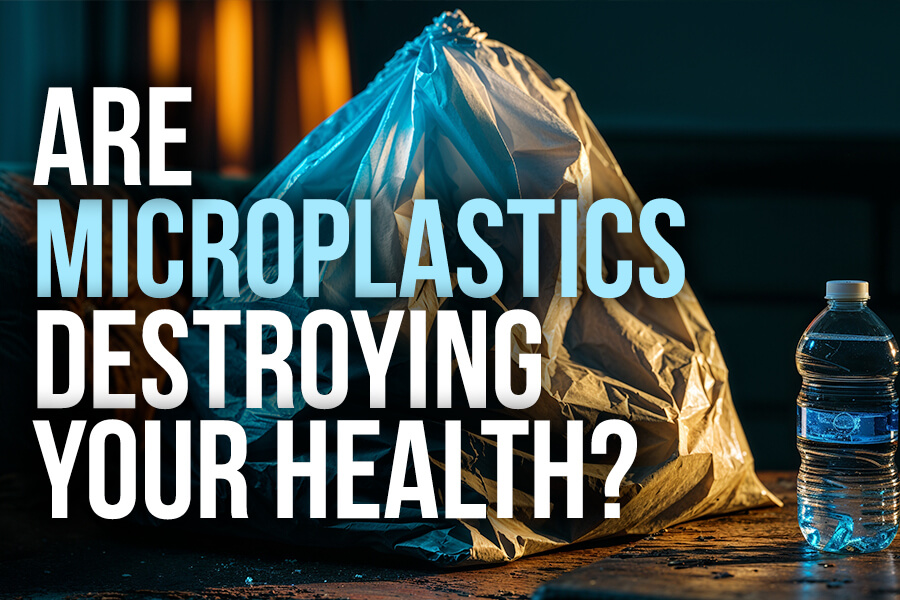 Are Microplastics Destroying Your Health?
Are Microplastics Destroying Your Health?
Did you know the average person consumes a credit card’s weight in microplastic particles every week and a dinner plate’s worth of weight of microplastic particles in a year!!
You probably know that plastics can pose some health risks and can damage the environment. How about microplastics, though? Microplastics are tiny plastic materials that are difficult to see. You are exposed to them daily without even knowing about it.
Yet, these tiny microplastic materials can seriously impact your health and well-being. So, what can you do about it? This is exactly what we are going to talk about today.
In this article, you will learn what microplastics are. I will go over the different types of microplastics. You will understand the problem with microplastics, including health and environmental concerns. I will share my tips on how to reduce your microplastic exposure and share some tips on how to detox from microplastics.
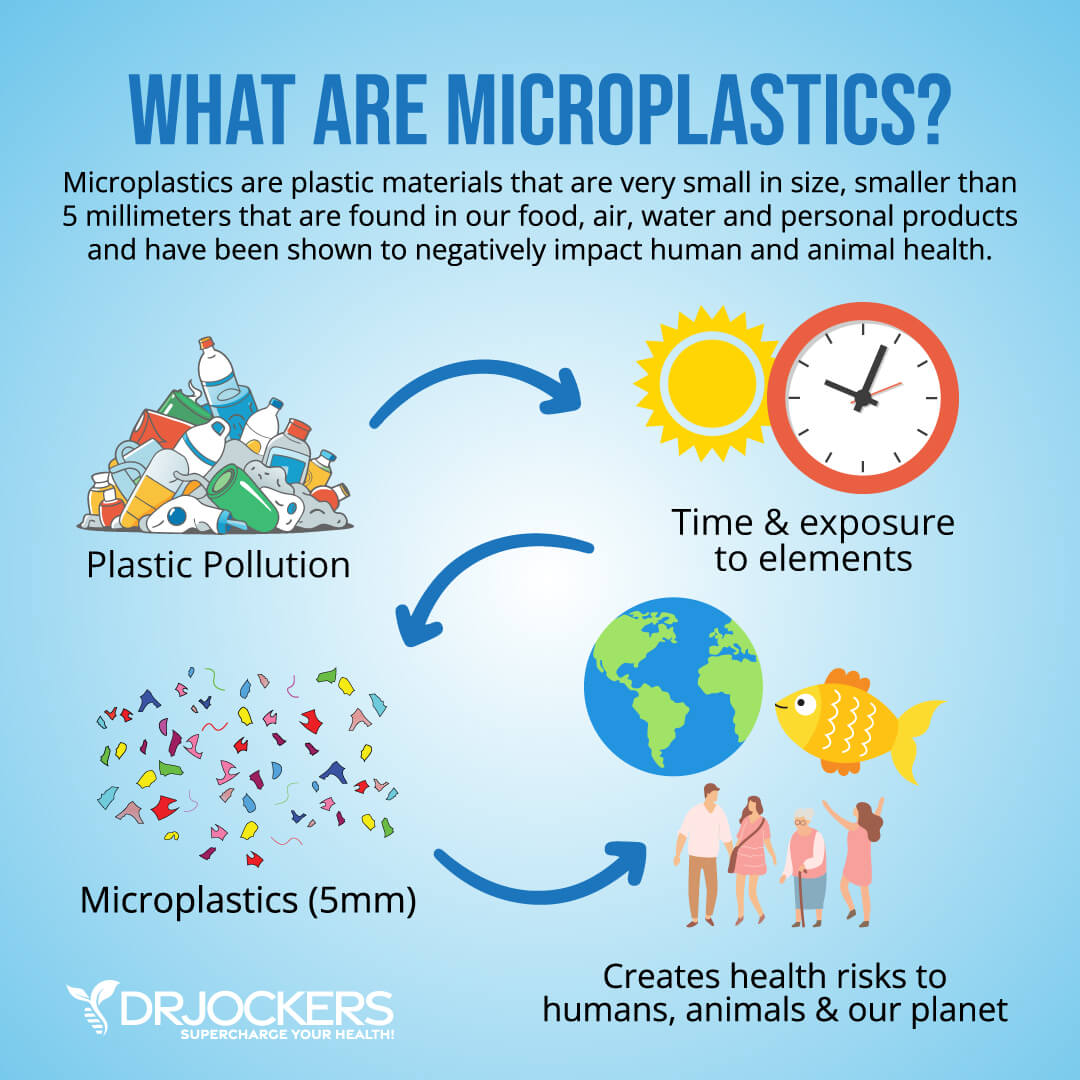
What are Microplastics
The term plastics refers to various materials made up of synthetic compounds, such as petrochemicals and semi-synthetic organic compounds (1).
They are polymeric materials, which means that they can be molded or shaped when applying heat or pressure and can be made into a variety of products; for example, flexible garden hoses are made from polyvinyl chloride (PVC), food containers from polystyrene, and tough and lightweight drink bottles made of polyethylene terephthalate (PET).
But what are microplastics compared to plastics? Microplastics are plastic materials that are very small in size, smaller than 5 millimeters. They can be hard to see or even invisible to your eye. Microplastics disintegrate from larger pieces of plastic. They can also be found in many of our products, including containers, exfoliants you use on your skin, and many clothing materials.
A major problem with plastics is that they don’t biodegrade readily. However, when exposed to ultraviolet light or to physical abrasion, plastics can break up into much smaller pieces. This is how we end up with microplastics.
Certain microplastics are purposely made small to fit a specific purpose. These are called primary microplastics. Primary microplastics include plastic pellets, which are melted to form larger plastic items. Primary microplastics also include microbeads that are used for personal care products, including face washes, cosmetics, and plastics.
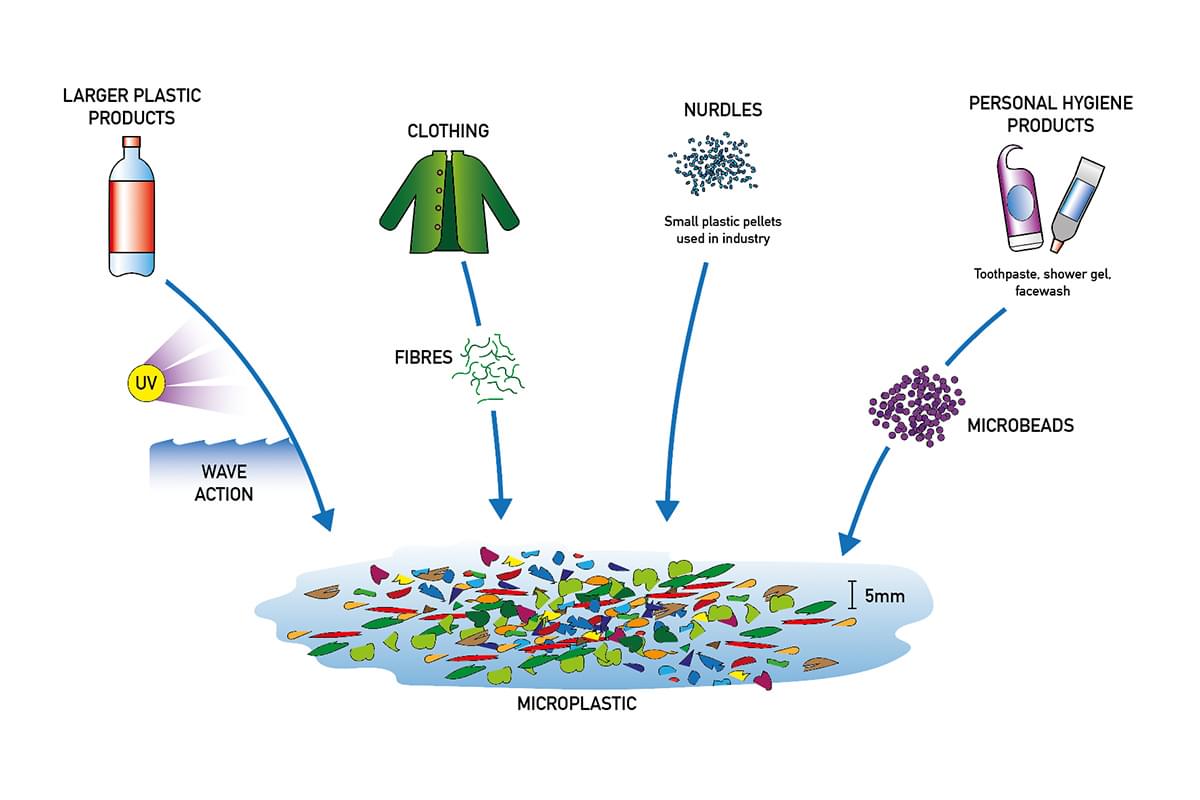
Secondary microplastics are microplastics that break down from larger plastics, including plastic bags, plastic bottles, or plastic toys. This may happen either through heat, sunlight, wind, ocean waves, or physical force from human use and manufacturing. Microfibers in furniture, clothes, and other cloth materials, fishing nets, and lines are also secondary microplastics when small pieces break off through wear and tear, washing, drying, and other uses.
One good example of microplastics is those found in our waters. A lot of plastics end up in our ocean water and other water sources, such as seawater, lakes, and rivers. There, they are constantly exposed to sunlight and sometimes even abrasion, when hitting rocks, for example.
This makes them break down into tiny pieces of microplastics. These microplastics flow through our water; they are everywhere in our marine ecosystem and affect our wildlife, waterways, and the food we get from our oceans.
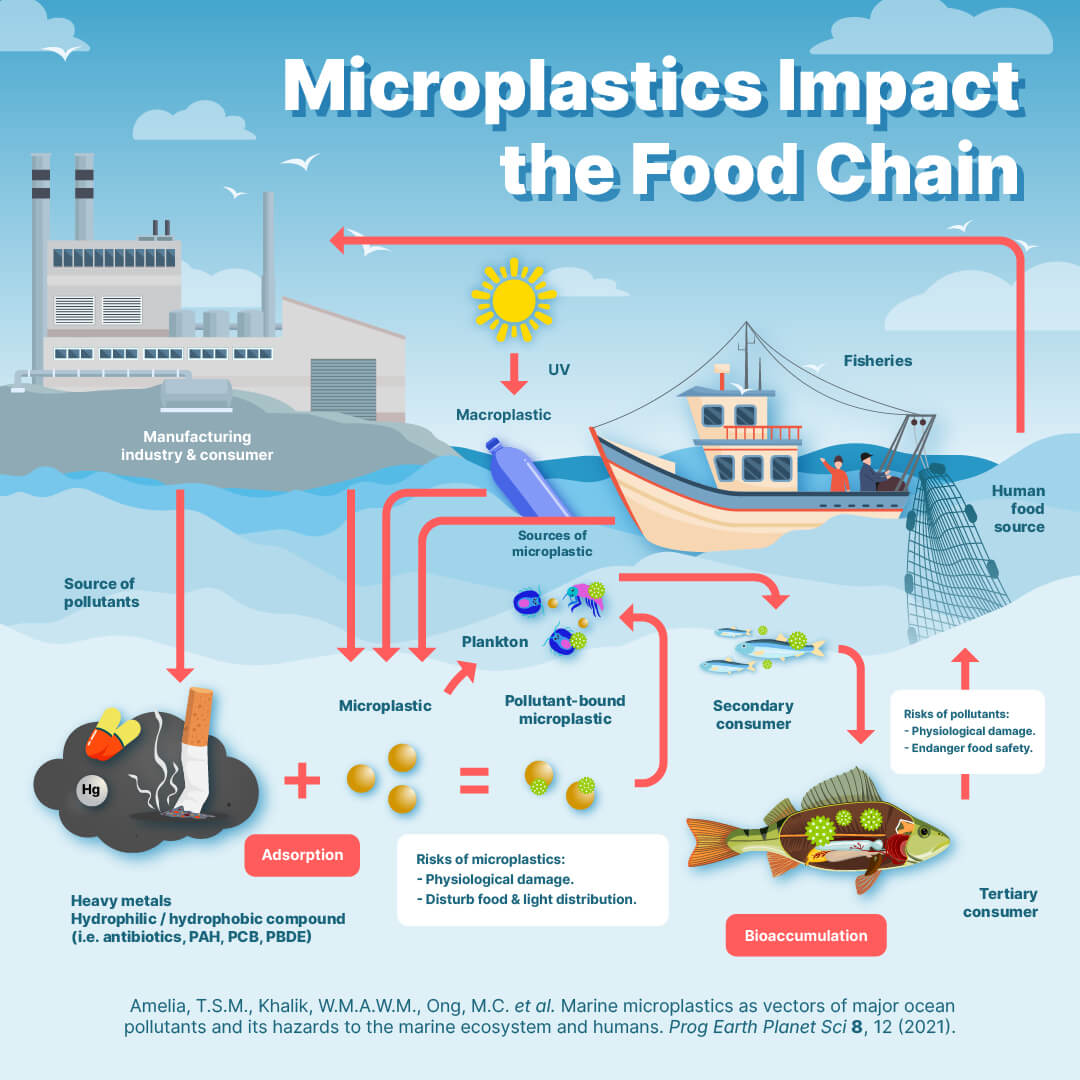
A 2018 scientific review published in Current Environmental Health Reports found that since the 1960s, plastic production on our planet has increased by 8.7 percent (2). This also means, according to the review, that 5.25 trillion plastic particles enter and circulate in our ocean surface water.
This is a conservative estimate, so the true number may actually be much higher. What’s even more shocking is that though some plastics and microplastics get into our water through the maritime ocean, most of it, around 80 percent, comes from land-based sources.
Besides our water systems, microplastics can be found in other water sources, including rain, snow, and even our tap water supply. Microplastics may be found even in our remote environments, such as the Arctic ice, deep oceans, deserts, and oceans.
They can be found in our indoor and outdoor air, household dust, textile fibers, fertilizers, compost, and plastic mulch films. They may be found in many of our foods, especially fish and shellfish, salt, sugar, fruits, vegetables, coffee cups, and tea bags.
Microplastics can also be found in your body, including your blood, organs, breast milk, and placenta, through environmental and food exposure. In summary, microplastics are essentially everywhere around us and inside us.
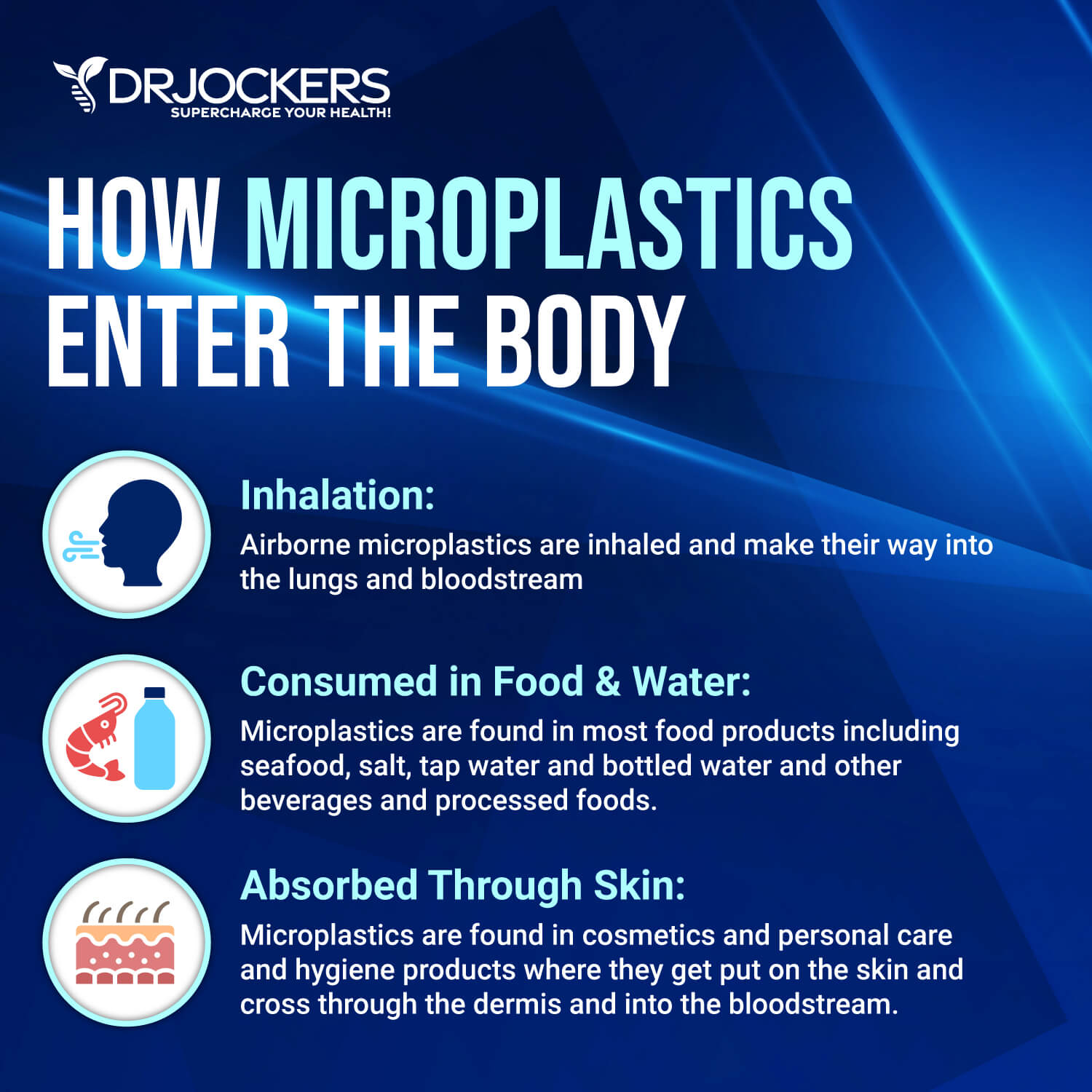
Types of Microplastics
There are many different types of microplastics you may encounter (1). The most common ones include:
Fibers
Fibers are microplastics that can come from various sources, including fleece clothing, cloth diapers, and even cigarette butts. Through our washing machines or even handwashing, fiber microplastics can get into our waterways.
While this can happen to cotton and wool, too, fleece microfibers and microfibers from clothes made from synthetic plastic materials are not biodegradable.
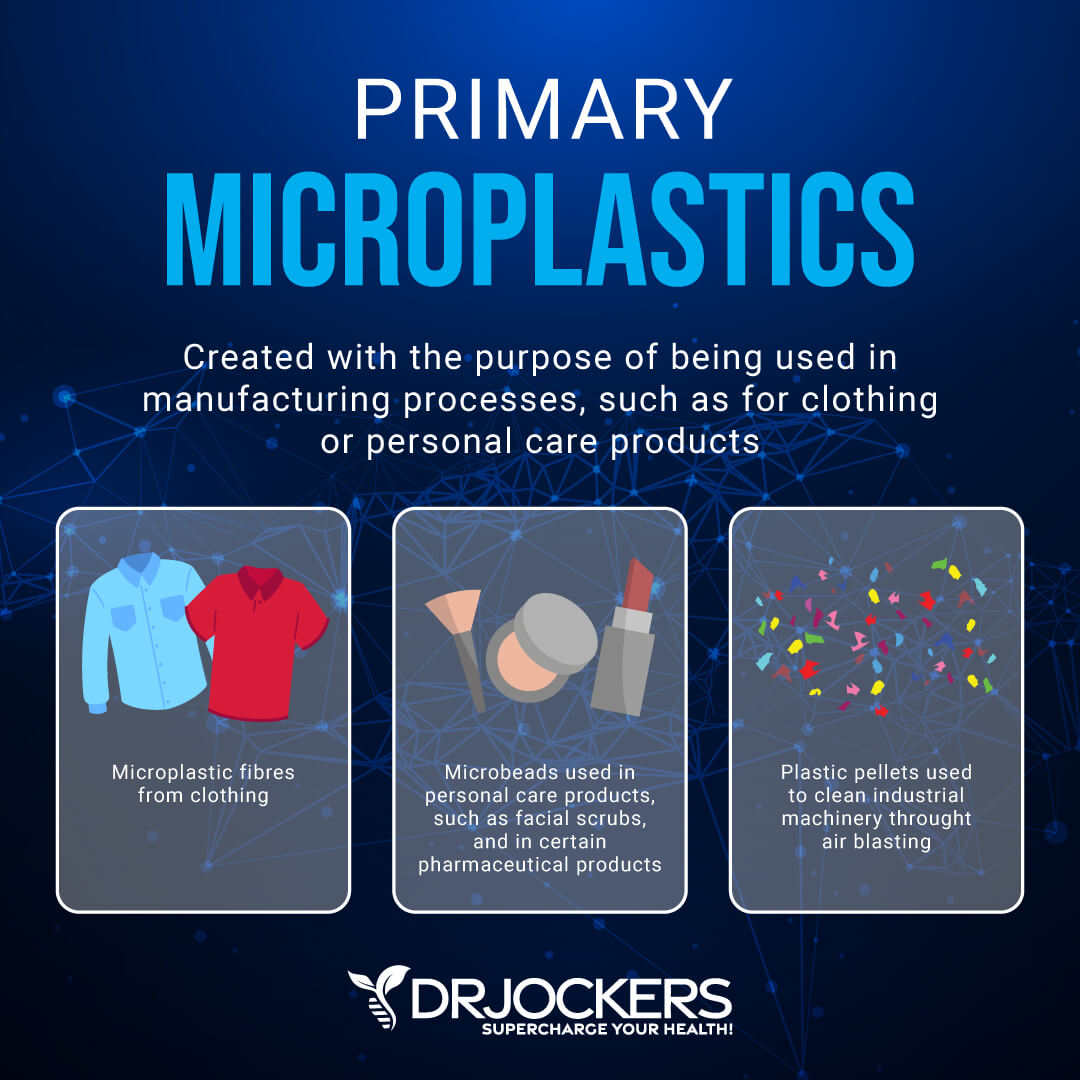
Microbeads
Microbeads are non-biodegradable microplastics that are smaller than one millimeter in diameter. Most commonly, they are found in personal care products, such as exfoliators, facial cleansers, and toothpaste.
Since they are found in our food system, they can affect our marine life, especially when fish mistake them for food. Microplastics are not digestible and can clog their digestive system, leading to health issues, starvation, or even death, or affect our food supply.
Fragments
Fragments are microplastics that are broken off from larger pieces of plastic and then broken into even tinier pieces through UV radiation from sunlight. They can commonly come from single-use plastic bottles, lids, and plastic cutlery.
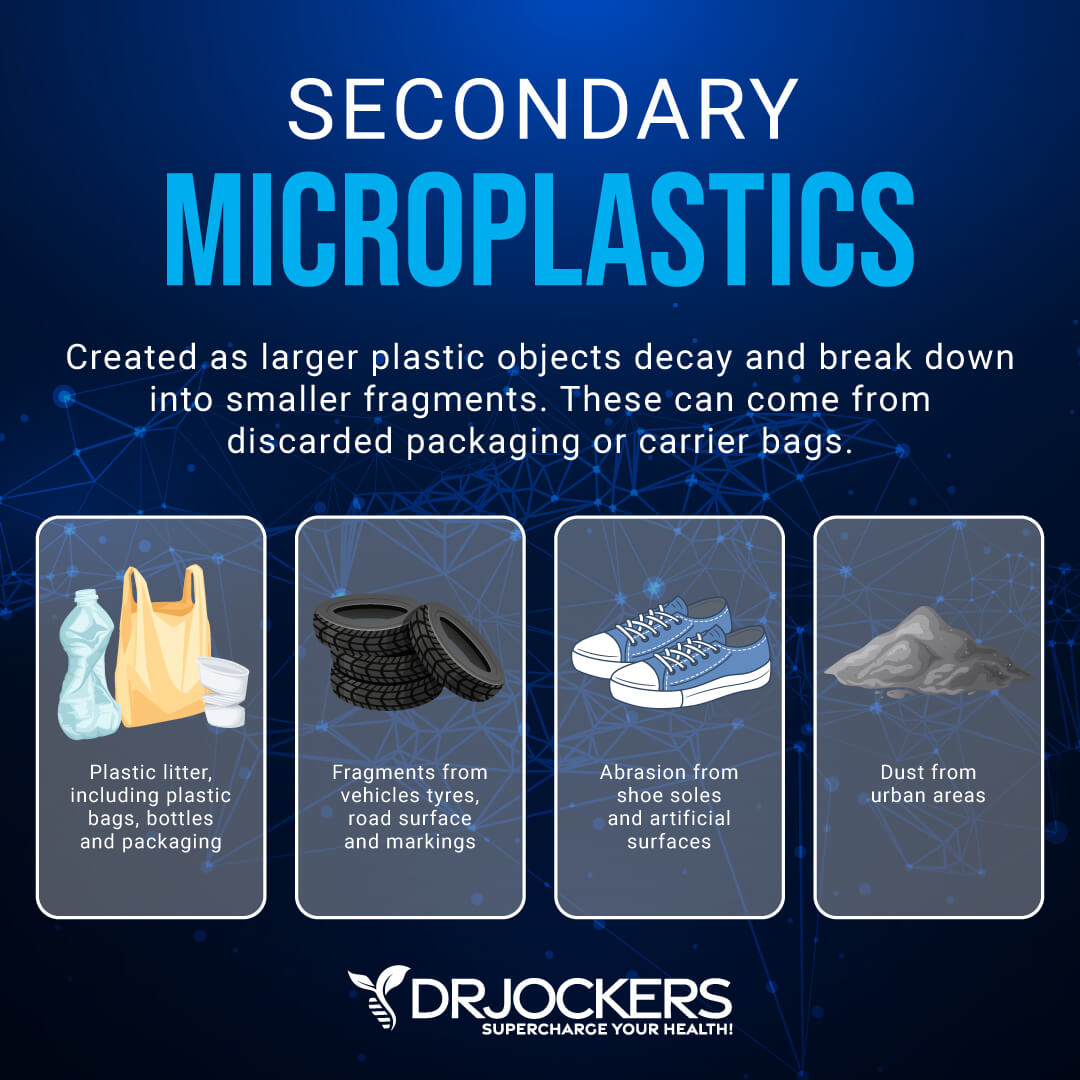
Nurdles
Nurdles are tiny plastic pellets that are used to make plastic products. Unfortunately, through transportation, they can easily spill and get into our drains and waterways, harming our fish and other marine life.
Foam
Foam or styrofoam can be found in food containers and coffee cups. Styrofoam cannot break apart easily, but when reheated with your food, it can break down into tiny pieces. This can be particularly harmful to human health if you are eating food or drinking something from heated styrofoam containers or cups.
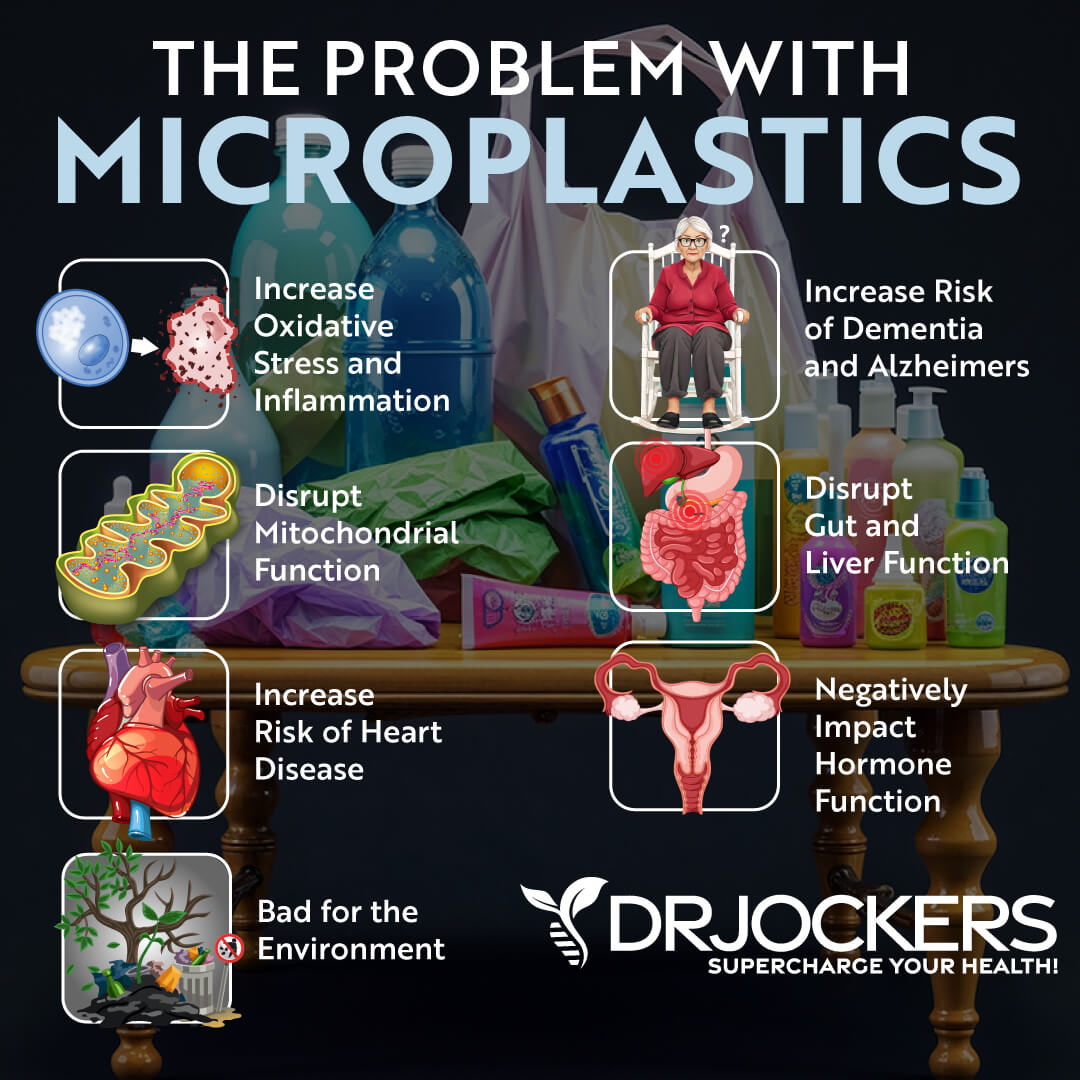
The Problem with Microplastics
Microplastics can be incredibly harmful and toxic to our environment, marine life, wildlife, and human health. Let’s go over the main problems with microplastics you need to be aware of.
Increase Oxidative Stress and Inflammation
When microplastics are inhaled or ingested, they may generate reactive oxygen species (ROS), which can result in a disruption in antioxidant defenses, cellular damage, and oxidative stress. They can trigger inflammatory responses and the release of pro-inflammatory cytokines, which can result in cellular damage, tissue damage, and even organ dysfunction. This may all increase the risk of the development of various chronic health issues, from cardiovascular problems to neurodegeneration.
A 2020 review published in the International Journal of Environmental Research and Public Health has discussed the potential toxic effects of microplastics and nanoplastics on mammals and humans (3). Nanoplastics are even smaller plastic particles, smaller than microplastics at 1 micrometer.
Based on research on mouse models and human cell lines, they found that microplastic and nanoplastic accumulation from chronic exposure can have negative effects and potential long-term consequences on mammalian and human tissues.
A 2020 review published in Redox Biology found that microplastics and nanoplastics initiate adverse effects by generating reactive oxygen species (ROS), triggering oxidative stress and inflammation (4).
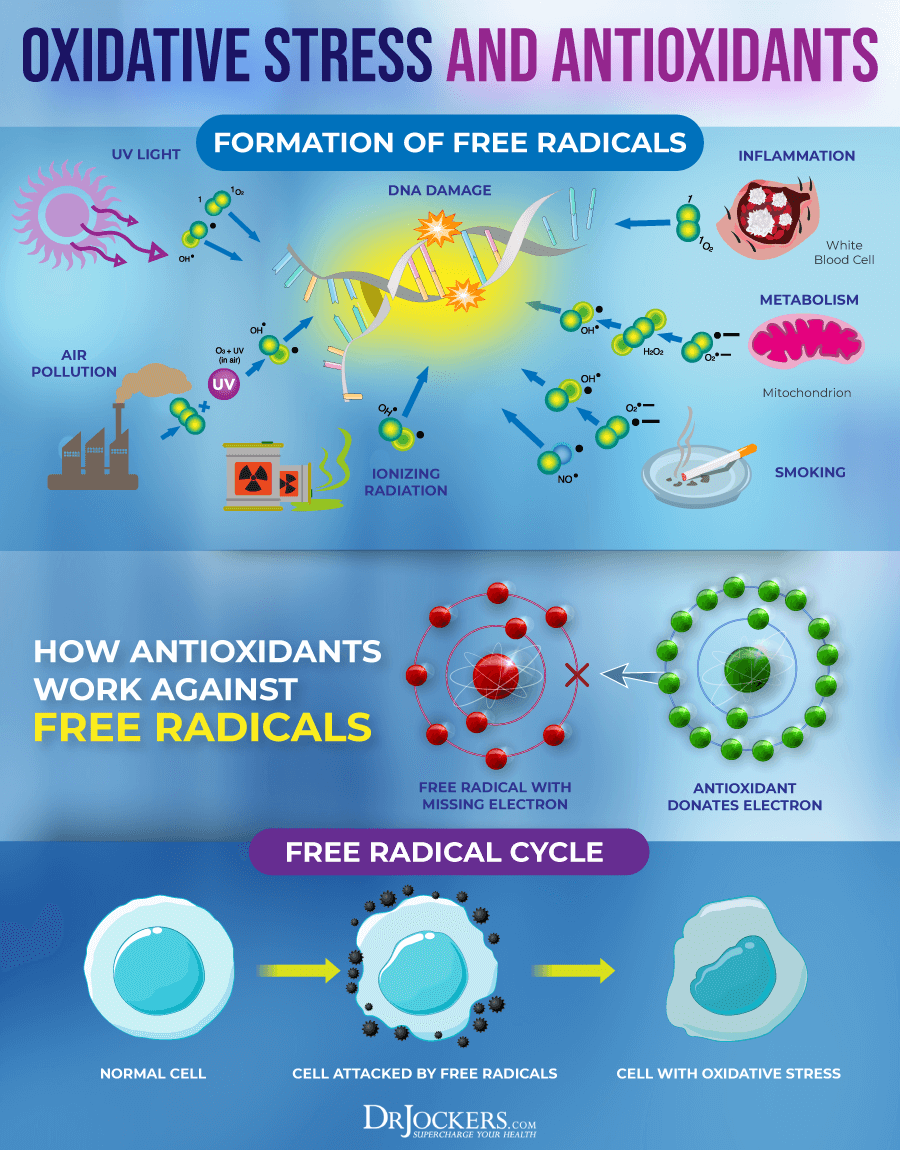
This cascade of cellular damage from inflammation and oxidative stress can result in negative outcomes such as inhibited growth and altered behavior. Researchers warned that this oxidative stress and inflammatory response can lead to problems from a public health perspective in human health.
A 2024 review published in Antioxidants (Basel) has found that microplastics may contribute to inflammation, oxidative damage, mitochondrial dysfunction, cell membrane breakages, and mitochondrial dysfunction, which may contribute to the increased risk and development of heart disease, cancer, and other diseases, as well as, accelerated signs of aging (5).
Another 2024 research published in the Journal of Translational Medicine has found that microplastics may increase chronic inflammation, immune dysfunction, and gut microbiome function, which may lead to an increased risk of carcinogenesis, tumorigenesis, metastasis, and cancer (6). In all these studies, researchers urge further research and attention on the human and public health risks of microplastics.
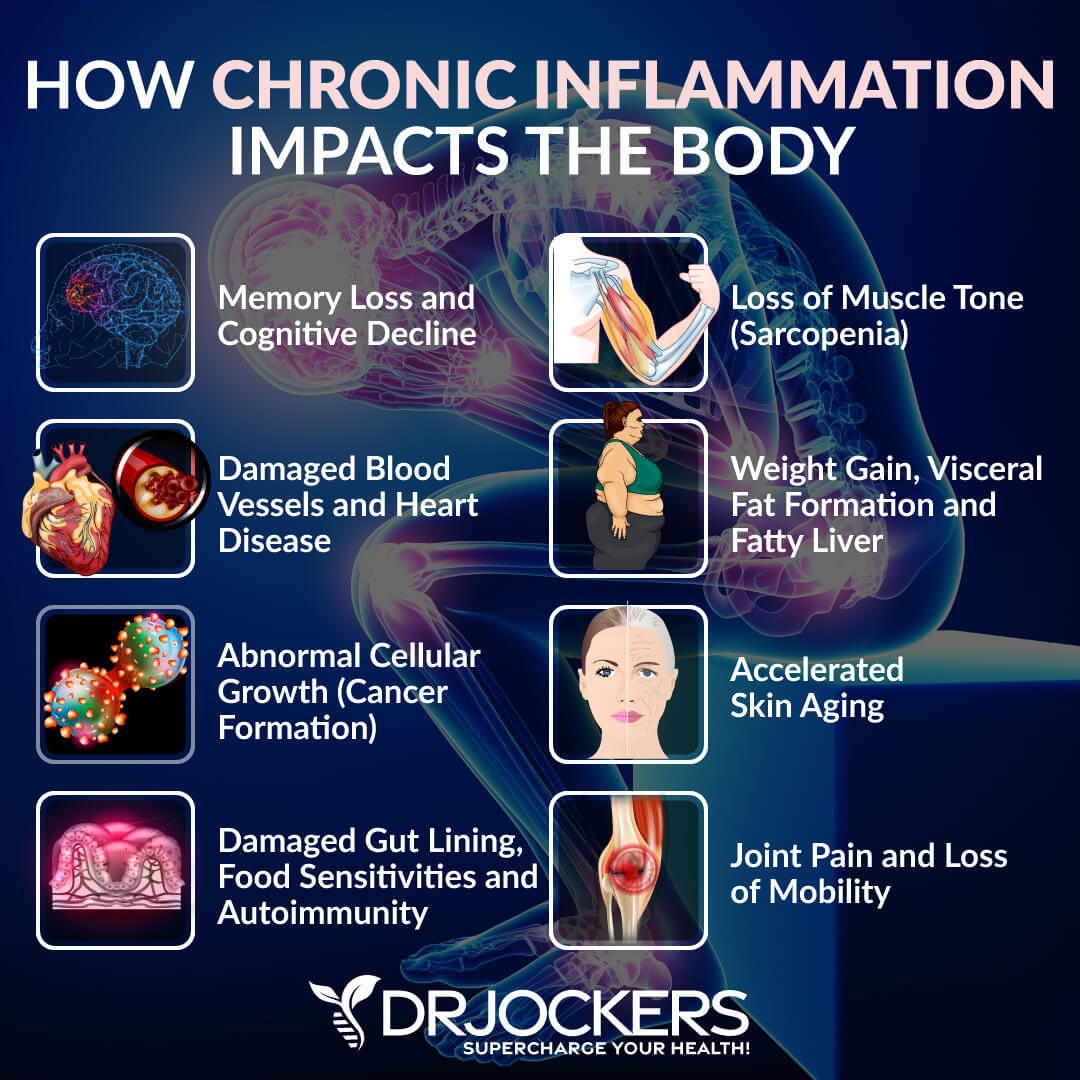
Disrupt Mitochondrial Function
Microplastics can accumulate inside your cells and disrupt mitochondrial dynamics, including fusion, fission, and overall energy production, and cause significant mitochondrial dysfunction. Mitochondrial dysfunction may contribute to increased oxidative stress, cause cellular energy imbalances, and disrupt cellular health and function, which may lead to an increased risk of age-related and chronic diseases.
A 2022 study review published in Metabolites has found that microplastics and nanoplastics can disrupt mitochondrial function and mitochondrial dynamics in animal and human cells, though the mechanisms of this are not yet fully understood (8).
A 2022 study published in Ecotoxicology and Environmental Safety found that polystyrene microplastics may cause mitochondrial damage to the GC-2 cells in mice, likely due to increased oxidative damage (8).
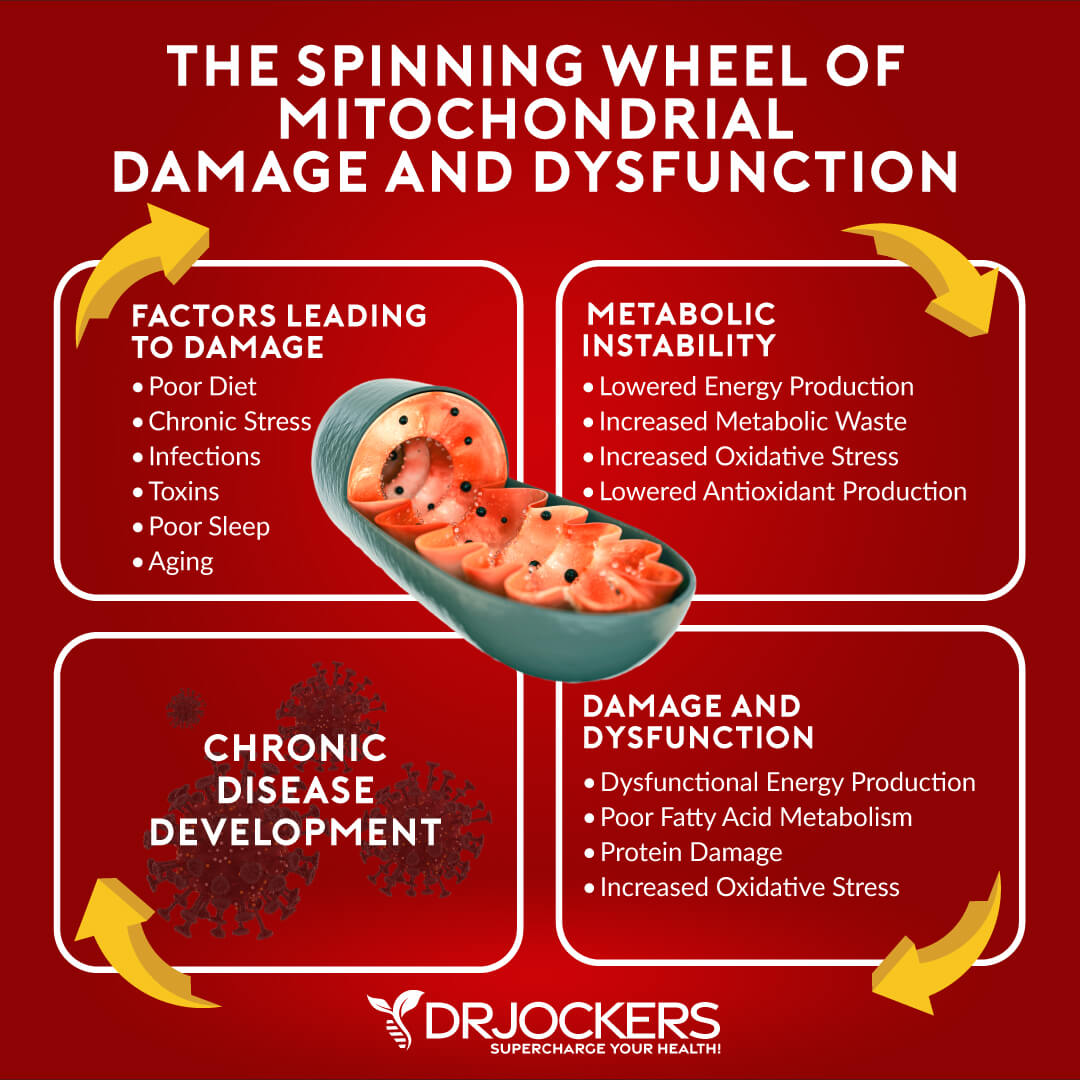
A 2024 study published in Plastics found microplastics and nanoplastics may cause oxidative stress and reactive oxygen species production, which can lead to changes in the mitochondrial membrane potential (9).
This may result in changes in mitochondrial dynamics, bioenergetics, and signaling pathways, which can negatively affect cellular metabolism and function, mitochondrial apoptosis, mitophagy, overall mitochondrial function and homeostasis, and overall health.
A 2024 review published in Antioxidants (Basel) found that microplastics may contribute to mitochondrial dysfunction, along with oxidative stress and inflammation, and increase the risk of age-related and chronic diseases, such as heart disease and cancer (5).
According to a 2025 research published in Food and Chemical Toxicology, by contributing to mitochondrial damage, microplastics and nanoplastics can increase aging and age-related diseases (10).
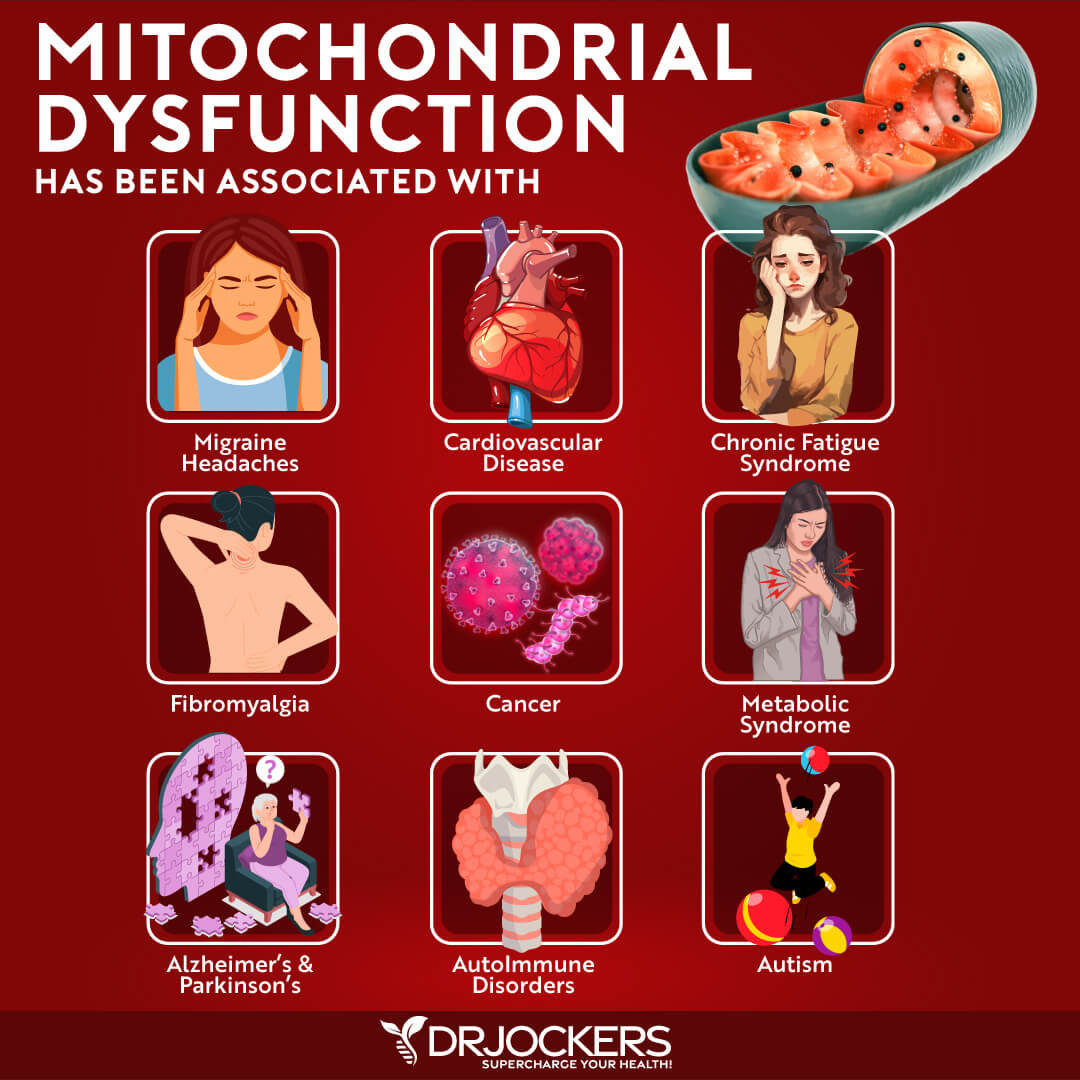
Increase Risk of Heart Disease
Microplastics may also affect your heart health and increase your risk of heart disease. The small particles of microplastics can enter your bloodstream. Once there, they may cause increased inflammation, oxidative stress, and blood vessel damage, all of which may contribute to plaque buildup in your arteries, atherosclerosis, heart disease, heart attacks, stroke, and other cardiovascular issues.
A 2024 study published in the New England Journal of Medicine found that microplastics may increase the risk of atheromas and cardiovascular events (11). Researchers studied a group of individuals who underwent carotid endarterectomy, which is a procedure to remove atherosclerosis from the neck region of the body. This was followed by the examination of the plaque taken from the neck blood vessels of 257 participants.
They found microplastics and nanoplastics in 58 percent of the plaques. This is over half of the participants. They checked for 11 different microplastics, and the two types they discovered were polyethylene and polyvinyl chloride. These microplastics can enter the body by breathing them in, through food, or by drinking. They may also be absorbed by your skin.
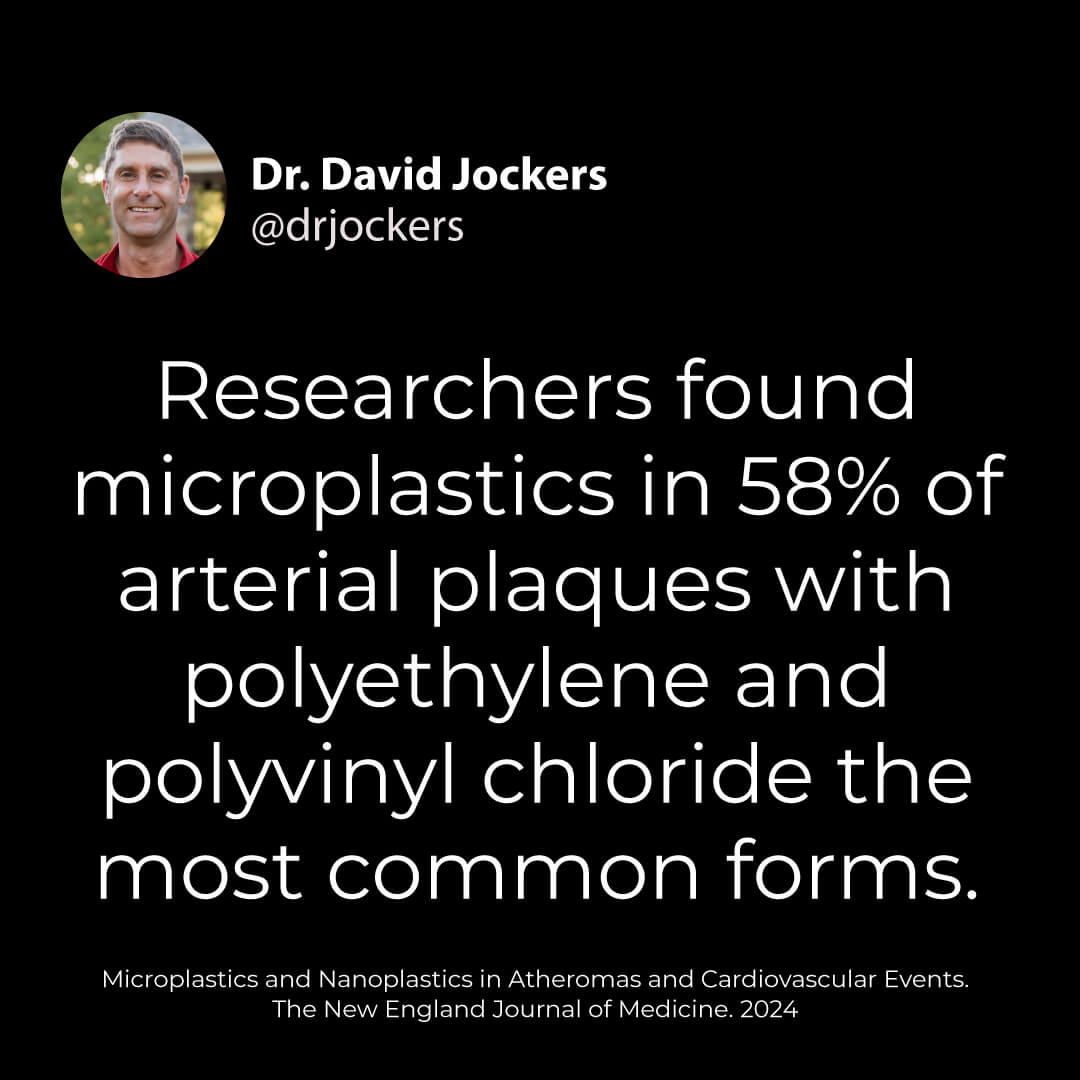
Researchers also found that participants with microplastic-containing plaques had higher inflammation markers than those without, which may indicate an increased risk of blood clots and related strokes or heart attacks. The higher levels of microplastics one had, the higher levels of inflammatory markers and health risks were found.
Researchers also followed these participants for about 3 years after their surgery and found that those with microplastics in their plaques had a 4.5-fold higher chance of stroke, heart attack, and death than those without.
They were also more likely to smoke, have diabetes, have high cholesterol, and have circulatory or heart issues. While the research didn’t prove that microplastics can directly cause cardiovascular events, it indicates a relationship between microplastics, plaque buildup, and heart issues.
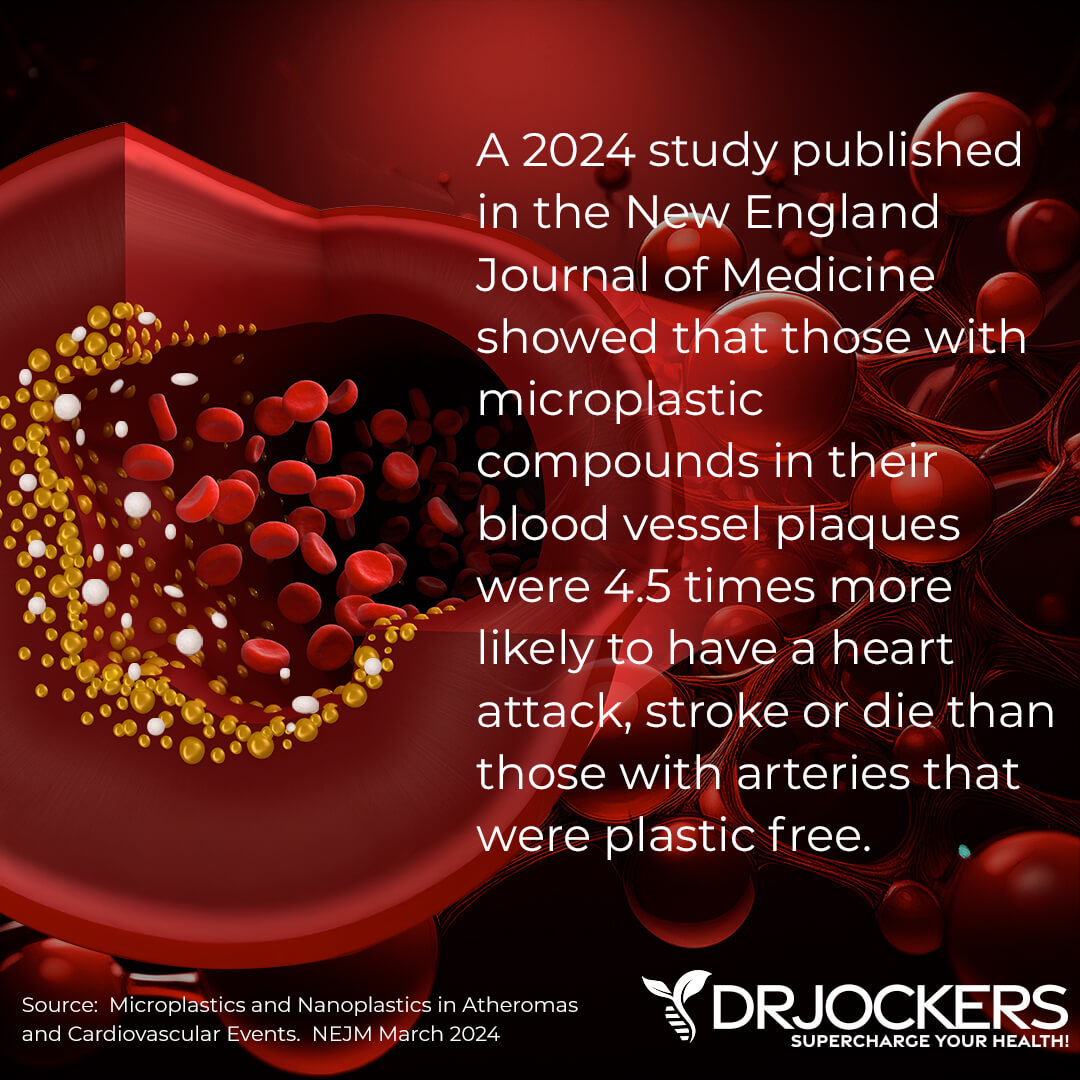
A 2024 review published in the European Heart Journal has also found that microplastics and nanoplastics may increase the risk of cardiovascular issues (12). Researchers found that increased inflammation, oxidative stress, platelet aggregation, cellular deterioration, and aging (senescence) may increase the risk of cardiovascular and metabolic issues, related diseases, and even premature death.
2024 research published in Particle and Fibre Toxicology looked at 101 participants, 82 individuals with acute coronary syndrome, and 19 control subjects, and their microplastic concentrations (13).
Researchers found that those with coronary issues had elevated microplastic concentrations and higher microplastic accumulations compared to the control participants. They found that microplastics may contribute to acute coronary events, and there may be a link between microplastics and the immunoinflammatory response and vascular pathology we see in acute coronary syndrome cases.
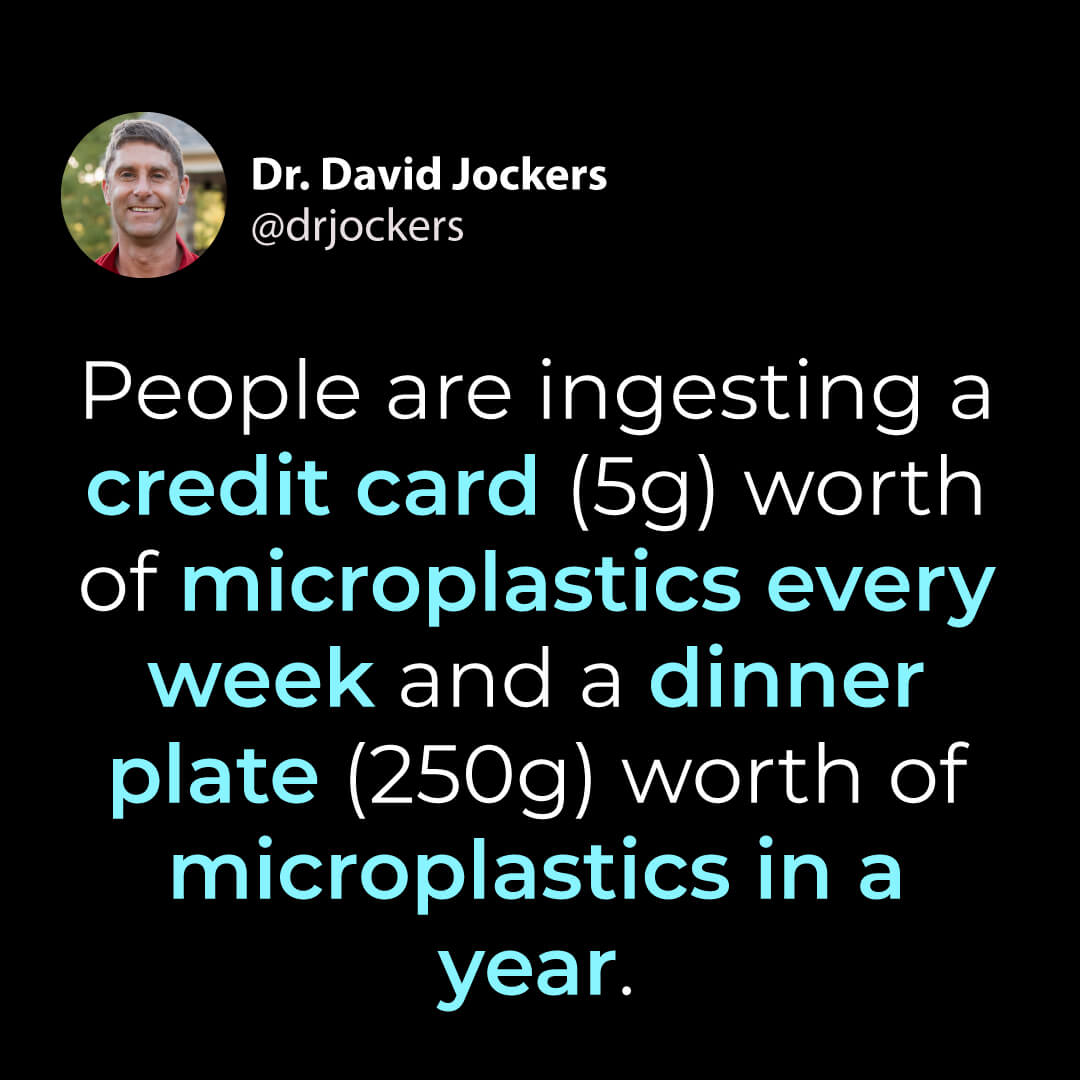
Increase Risk of Dementia and Alzheimers
Microplastics may also affect the brain and increase the risk of dementia and Alzheimer’s disease. Microplastic and nanoplastic particles can get into the bloodstream, cross the blood-brain barrier, affect the brain tissue, increase oxidative stress, increase inflammation, lead to a buildup of toxic proteins, and, as a result, increase the risk of accelerated brain aging and neurodegenerative disease.
A 2024 study published in Molecular Neurobiology has found that polystyrene microplastics may increase the progression of cognitive issues in patients with Alzheimer’s disease (14). Researchers found that microplastics may contribute to microglial pyroptosis and increase neuroinflammation, which can result in the progression of cognitive impairment in Alzheimer’s.
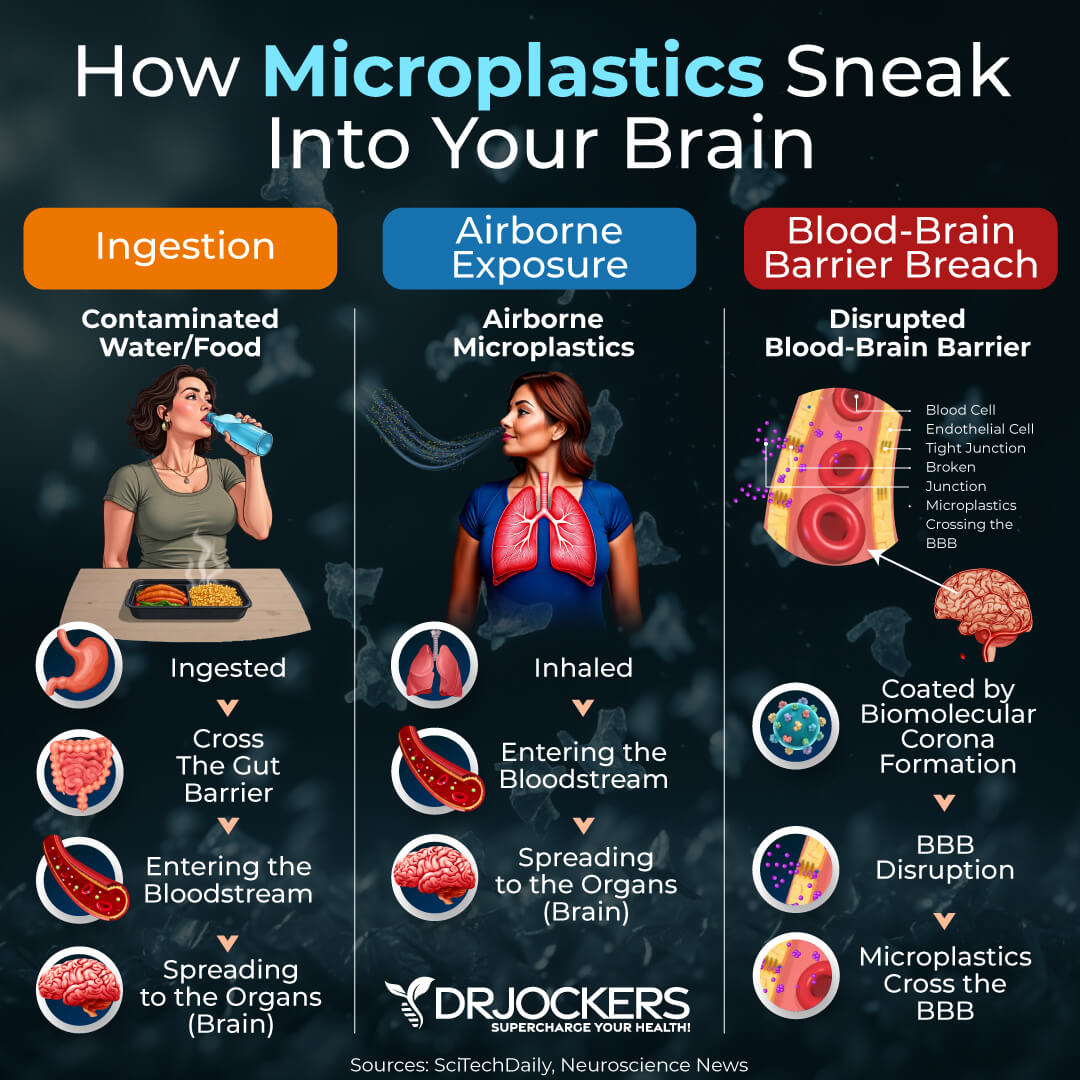
A 2025 research published in Nature Medicine also found that bioaccumulation of microplastics may affect the brain and increase the risk of dementia and Alzheimer’s disease (15). Researchers looked at frontal cortex brain samples, as well as right central parenchyma liver and wedge pieces containing cortex and medulla kidney samples from autopsy specimens dating between 2016 and 2024.
They found higher levels of microplastics and nanoplastics in the 2024 brain and liver samples than in 2016. The findings suggest a trend of increase in microplastic and nanoplastic concentrations in both the brain and the liver.
These concentrations were between 7 to 30 times higher in samples from dementia patients. This may suggest that there may be a link between neurodegeneration, dementia, Alzheimer’s, and microplastic levels in the brain.
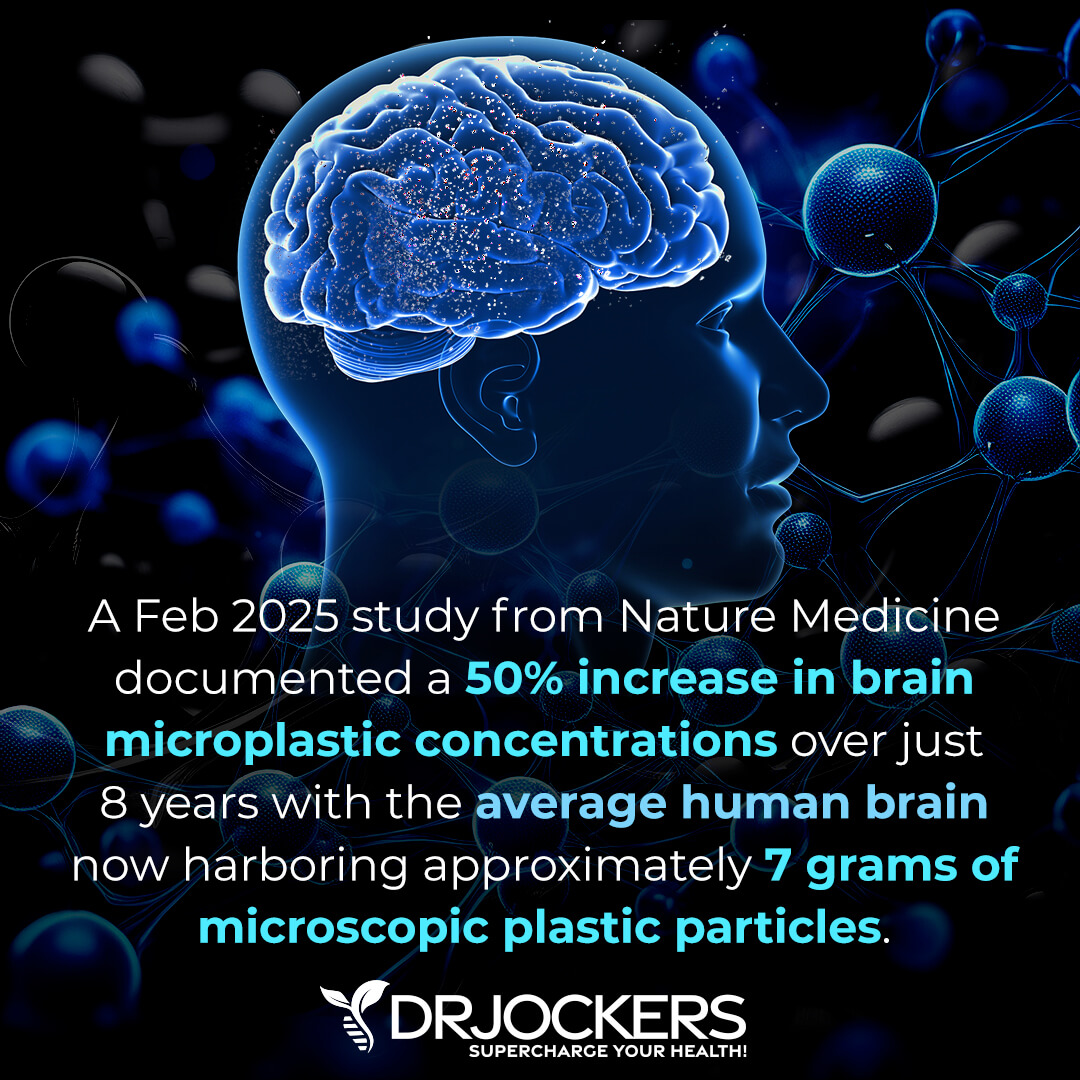
Disrupt Gut and Liver Function
Microplastics may disrupt your gut health and liver function as well. Once microplastics enter your body, they can accumulate in your gut, damage your gut lining, disrupt your gut microbiome health, and increase the risk of leaky gut syndrome.
Inflammation from microplastics may further increase gut health issues. These gut issues may contribute to the increased risk of digestive issues, obesity, diabetes, metabolic issues, and autoimmune disease.
Moreover, microplastics can contribute to toxicity and toxic buildup in your body, making your liver work overtime to detoxify. Chronic inflammation and oxidative stress from microplastic exposure may impact your liver’s ability to detoxify, which can become an even bigger problem when your body is overloaded with microplastic toxic particles. All this may increase the risk of liver-related health issues, including lipid metabolism disorders, liver fibrosis, and liver disease.
2024 research published in the Journal of Translational Medicine found that microplastics may increase gut microbiome function, chronic inflammation, and oxidative stress, which may increase the risk of cancer, among other health issues (6). As we discussed in the earlier section, a 2025 research published in Nature Medicine has also found an increased trend in the bioaccumulation of microplastics and nanoplastics in the liver (15).
A 2024 review published in Science of the Total Environment looked into how microplastics may affect the gut-liver axis (16). Your gut, gut flora, and liver are connected through something called the gut-liver axis, so this is an important aspect of the effects of microplastics we need to talk about. As mentioned, microplastics can change gut microbiome balance and liver function. They may promote gut dysbiosis, gut barrier damage, and liver damage.
When microplastics damage the intestinal barrier, they can pass through, reach the liver, and affect both the gut and the liver. According to this review, this process can contribute not only to gut dysbiosis but also to liver injury. Researchers suggest that supporting the gut flora may be a way to reduce both gut dysbiosis from microplastics and microplastic-related liver damage.
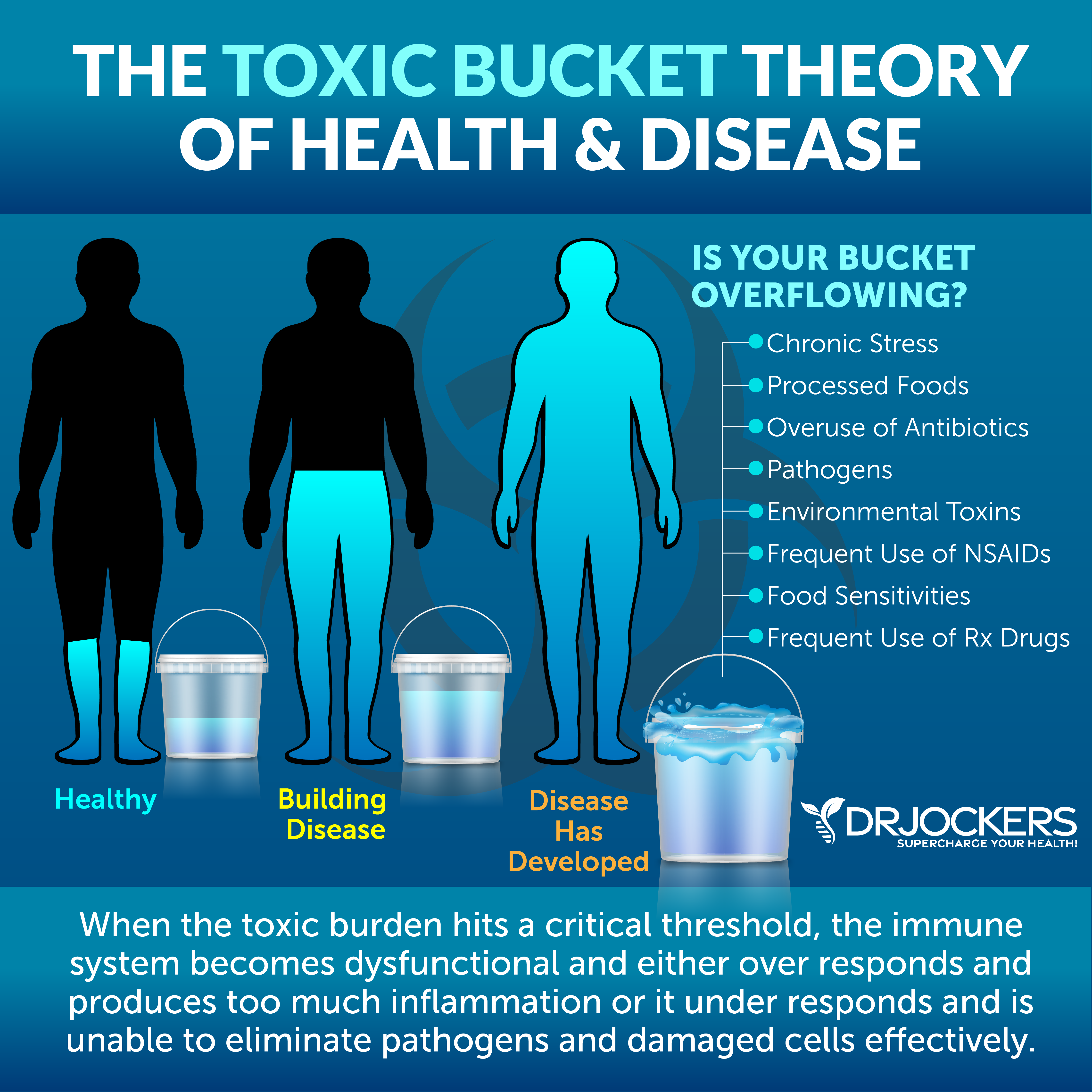
Negatively Impact Hormone Function
Because microplastics can act as endocrine disruptors, they may also interfere with your body’s hormone regulation and negatively impact your hormone function. This means that they can impact sex hormones, such as estrogen and progesterone, as well as other hormones, such as your thyroid hormones.
This hormonal impact may increase the risk of all kinds of hormone-related issues, such as infertility, developmental problems, metabolic disorders, thyroid issues, and hormone-related cancers.
A 2023 review published in Frontiers in Endocrinology found that microplastics and nanoplastics may have endocrine-disrupting effects (17). This means that they can impact the ovaries, testes, thyroid gland, pituitary gland, adrenal gland, and the hypothalamus and related hormonal functions.
Exposure to microplastics may increase reproductive toxicity, decrease sperm quality, and lead to developmental abnormalities, according to the review.

A 2024 review published in the Science of the Total Environment has found that microplastics may impact reproductive health (18). The review found that microplastics may impact the neuroendocrine system, which can affect sex hormone synthesis through the hypothalamic-pituitary-gonadal (HPG) axis.
Microplastics may also pass the blood-testis barrier, which can negatively affect spermatogenesis in men. It may also increase the risk of ovarian atrophy, fibrosis, placental dysfunction, and endometrial hyperplasia in women, which may all impact reproductive health and fertility.
Moreover, microplastics may also impact the health of the developing baby during pregnancy. Researchers believe that microplastic pollution may be one of the contributing factors to global fertility decline.
A 2024 review published in Frontiers in Endocrinology found that microplastics may also impact thyroid function and increase the risk of related health issues (19). This review looked at the link between environmental factors and thyroid health based on recent data.
They discovered that endocrine-disrupting chemical exposure can negatively affect thyroid function, as certain chemicals may either mimic and/or disrupt the synthesis, release, or action of thyroid hormones.
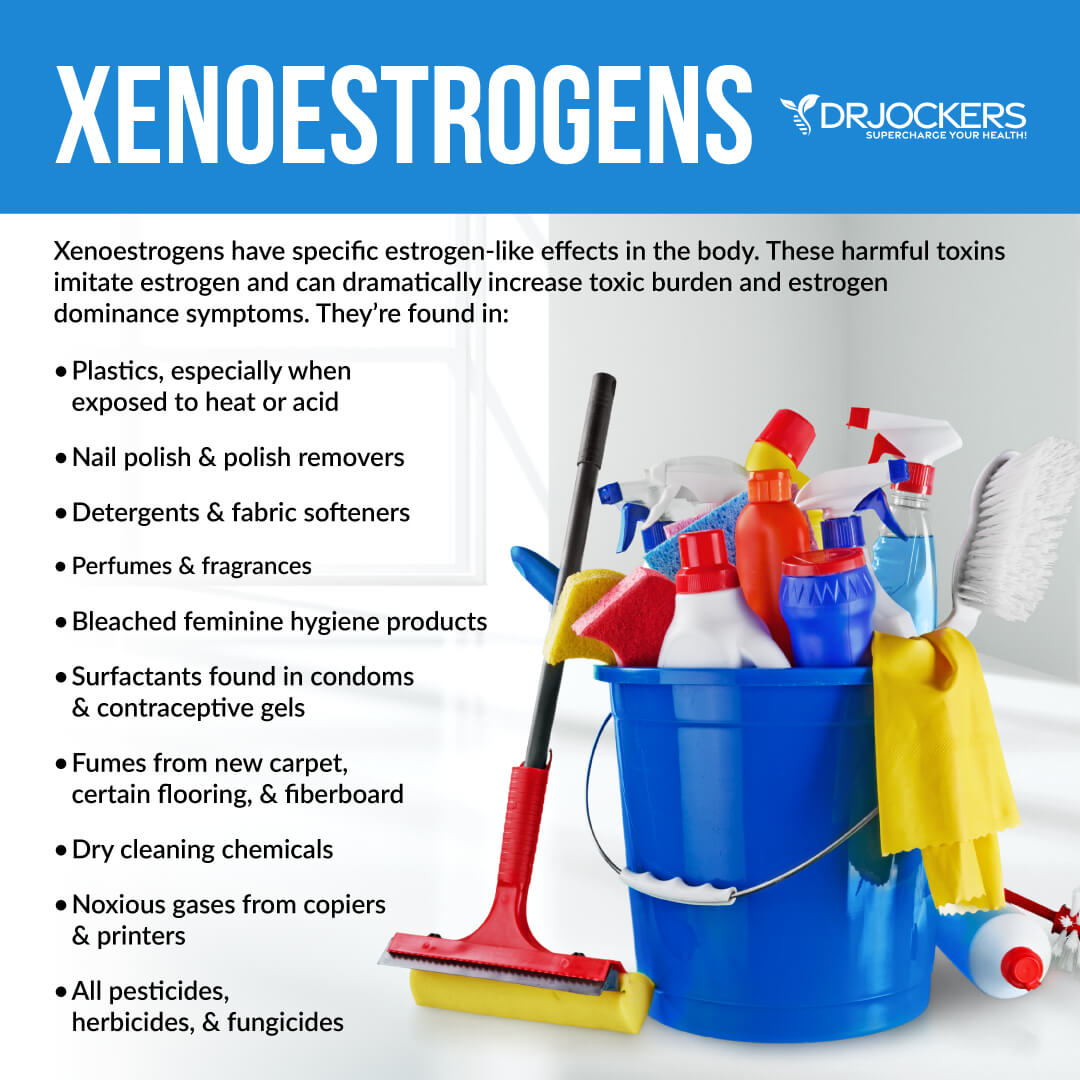
These endocrine-disrupting materials include microplastics and nanoplastics, which, according to the review, may impair the epithelial barrier and immunological responses in the body. Researchers found that chronic exposure to microplastics and nanoplastics may affect serum T3 and circulating thyroid hormone levels, which can increase TSH levels and result in thyroid issues.
It turns out that not only chronic but possibly even shorter-term exposure can be problematic for your hormonal health. A 2024 animal study published in the Journal of Hazardous Materials has also found that even short-term exposure to microplastics and nanoplastics may contribute to thyroid and parathyroid disorders (20).
Researchers found parathyroid gland dysfunction, structural impairment, and functional thyroid damage in mice after being exposed to microplastics and nanoplastics through ingestion or respiration.
They found that micro- and nanoplastics had a negative effect on thyroglobulin (TG) synthesis, which is a protein made by the thyrocytes in the thyroid follicles. This damage in the thyroid follicular cells occurred because microplastics and nanoplastics seem to affect the expression of PAX8 protein and cAMP response element binding protein (CREB). Moreover, research also found changes in the TSH levels in the pituitary gland due to microplastic and nanoplastic acting, which can further impact thyroid hormone secretion and thyroid function.
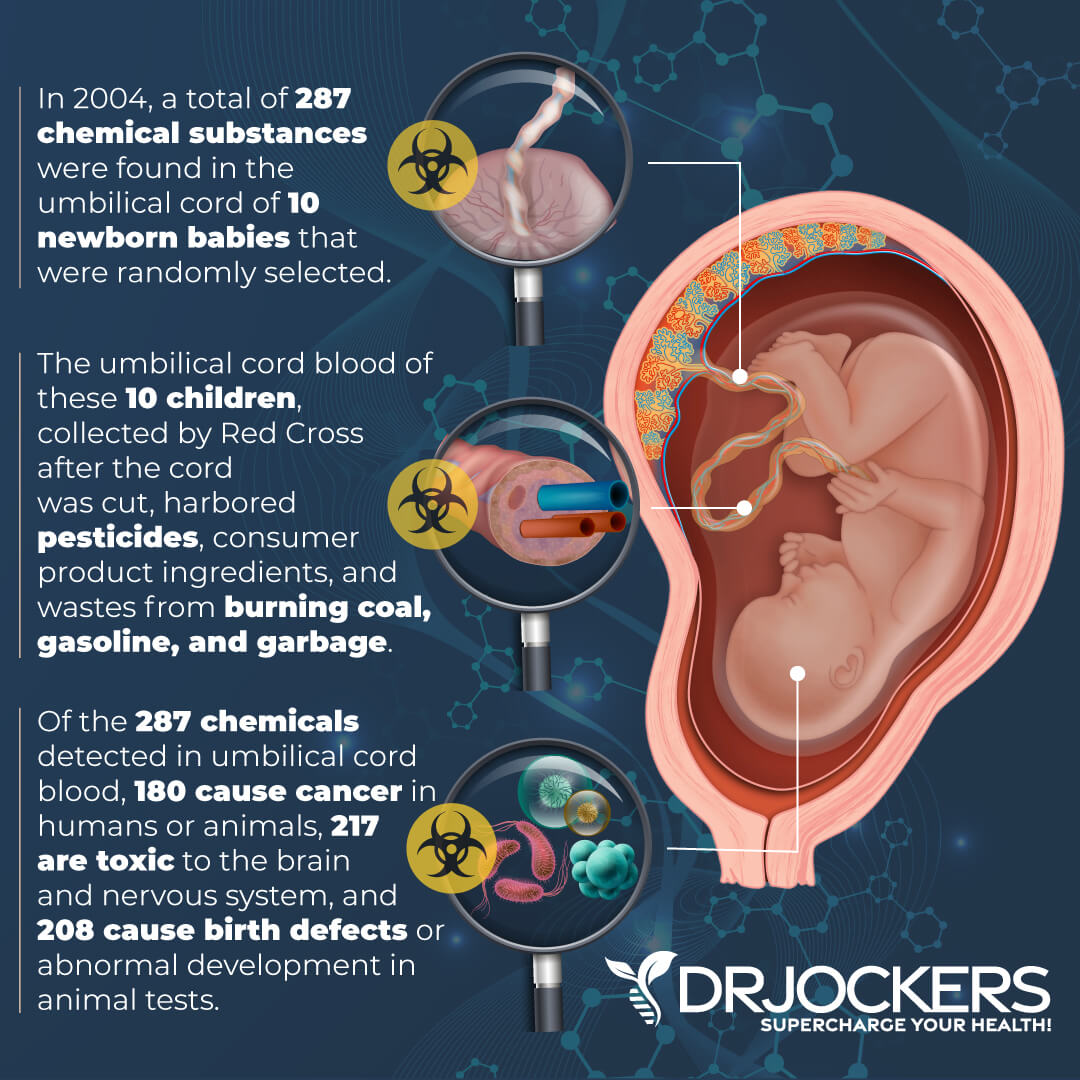
Bad for the Environment
Finally, microplastics are also bad news for the environment. We already talked about how microplastics affect our oceans, seas, and other bodies of water. This can have a serious effect on our entire ecosystem, including our animals. Animals living in our waters can ingest these microplastics, and if they are at the bottom of the food chain and get eaten, they spread them to other animals or even humans through seafood.
A 2019 research article published in Environmental Sciences Europe has found that while it can take hundreds of years for plastics to break down, plastics can turn into microplastics and nanoplastics much quicker (21). This means that larger plastics landing in our waters can quickly turn into microplastics and affect the marine environment, including zooplankton, fish, and other sea life.
As you already know, microplastics contain endocrine-disrupting chemicals that can impact not only mammals in our waters but also mammals and humans that consume seafood contaminated with microplastics.
But it does not hurt our oceans. Microplastic pollution can negatively impact our land environment and terrestrial ecosystem as well. A 2018 scientific article published in Global Change Biology has explained that plastics, microplastics, and nanoplastics can be hazardous to our terrestrial ecosystems (22). This includes our rainforests, forests, deserts, and grasslands, basically every area of our planet you can think of.
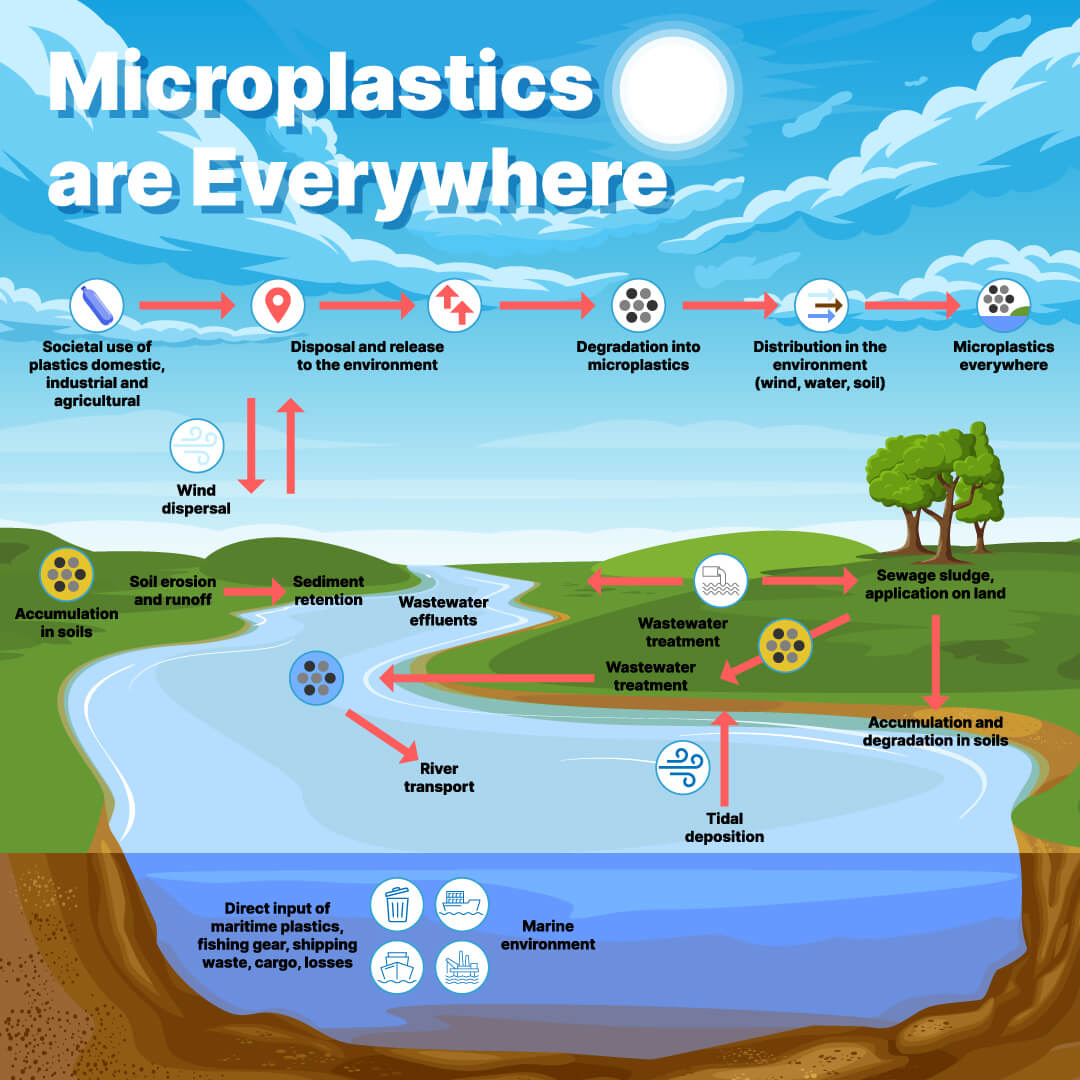
According to the article, microplastics can disrupt the health and function of terrestrial organisms. This can include plant pollinators, terrestrial fungi, and soil-dwelling invertebrates. This means that microplastics can indirectly impact the health of our soil and plants and our agriculture. They can also impact the health of our land animals, including the animals we consume or the food the animals we raise for food consumption.
No matter what it impacts, essentially, it will impact our health as humans as well. And when we talk about human health, we can’t forget about our drinking water. Tap water toxicity is already a health concern in the United States, but also around the world, and since our tap water comes from bodies of water, microplastic toxicity can happen.
Microplastics can also make it into our tap water system by using personal hygiene and cleaning products that contain microplastics, such as face wash or toothpaste. Moreover, a lot of people drink bottled water to avoid tap water.
However, most bottled water is bottled in plastic bottles, which is a huge risk factor for problems related to plastics, microplastics, and nanoplastics. Not to mention, many of these plastic bottles will end up soiling our lands and waters, further contributing the the microplastic crisis in our world.
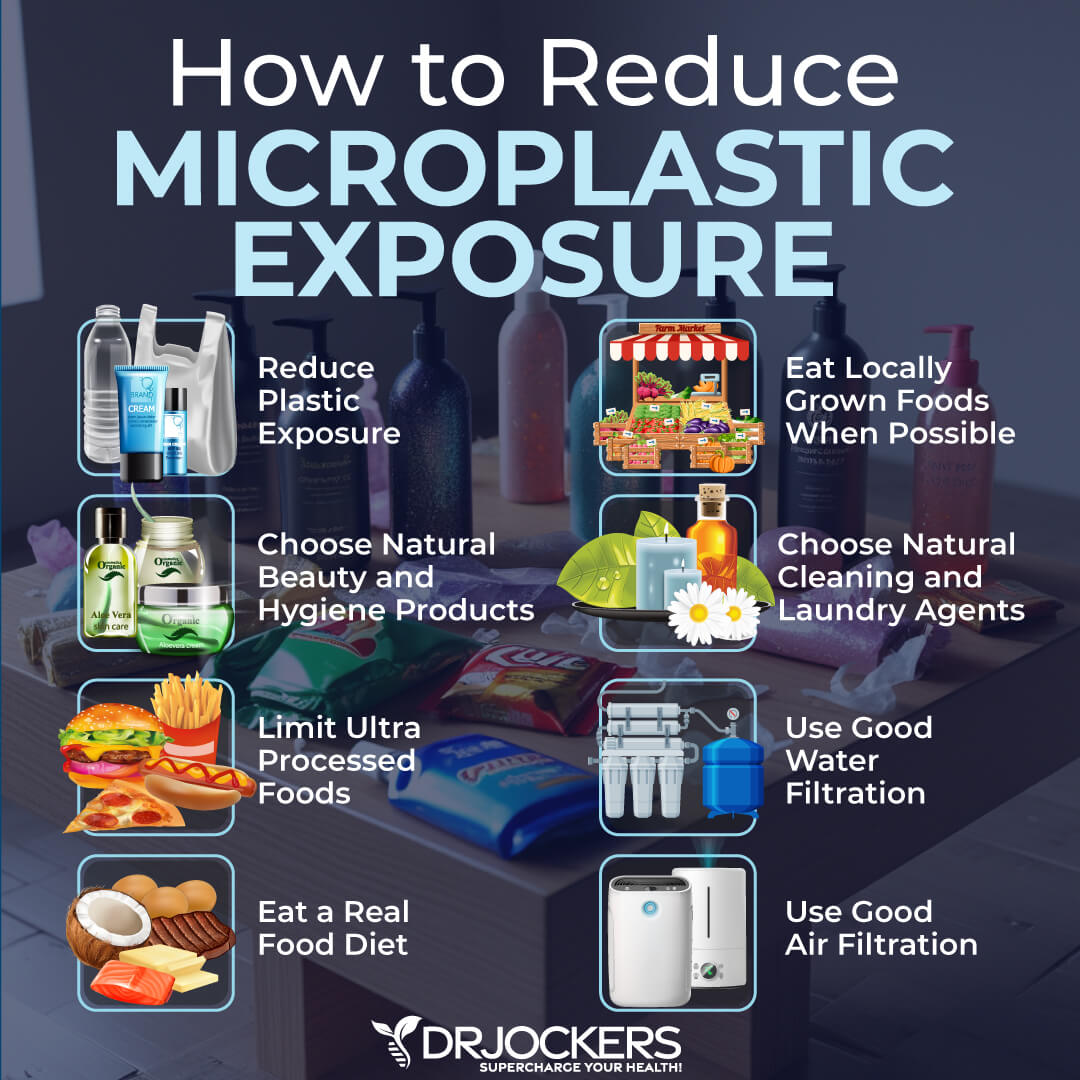
How to Reduce Microplastic Exposure
Unfortunately, microplastics are everywhere. Escaping them completely may be impossible, but it is certainly possible to decrease your exposure and related health risks. Here are my top tips on how to reduce your microplastic exposure.
Reduce Plastic Exposure
Reducing your plastic exposure is one of your most important steps. Avoid building drinks and food packaged in plastic. Instead of using plastic to store food, choose glass Tupperware. You can buy ziplock bags made from cloth or silicone or use beeswax wrappers.
Avoid cooking in plastic. If, for any reason, you have to buy or be served food in a plastic container or plastic plate, do not microwave it in it, but heat it in an oven or stovetop in a pan.
Avoid plastic utensils, cups, or plates. Ideally, you don’t want to use anything that can only be used one time, but if you must, there are great options made from bamboo and other natural, biodegradable materials.
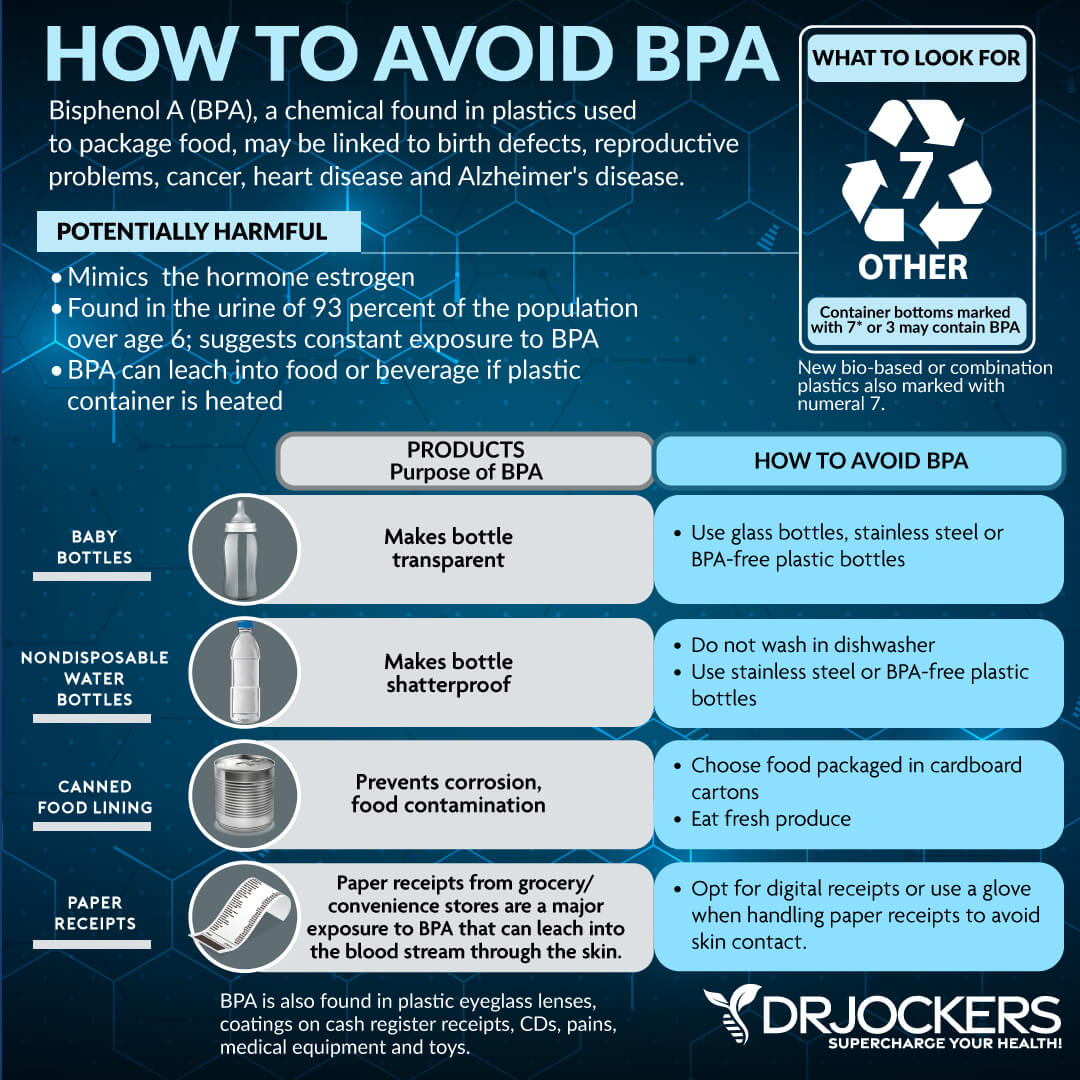
Choose Natural Beauty and Hygiene Products
Conventional personal hygiene and beauty products are not only packaged in plastics but may also contain microplastics, such as microbeads in exfoliators and toothpaste. Instead of conventional products, choose organic or natural products.
Many natural products are sold in glass or other non-plastic containers. Choose those options if you can. You may also make your own products and store them in glass containers.
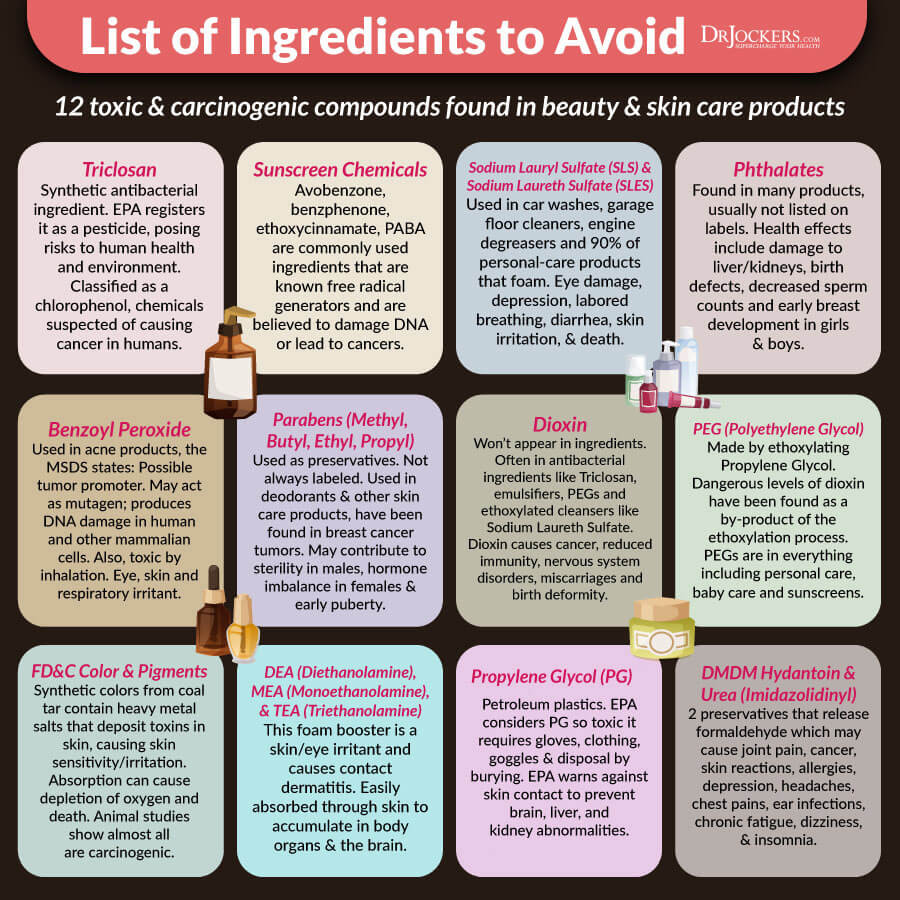
Limit Processed Foods
Limit or, ideally, eliminate your processed food intake. Processed foods are often packaged in plastic materials and are exposed to plastics through processing. Additionally, processed foods are generally highly inflammatory and not ideal for your health.
Instead of supporting your body’s detoxification pathways, processed foods can clog your body with more toxins and slow cleansing from microplastics and other harmful agents.
Instead, I recommend a real food diet. Eat a diet rich in greens, vegetables, sprouts, herbs, spices, fermented foods, low-glycemic index fruits, pasture-raised eggs, grass-fed meat, pasture-raised poultry, wild-caught fish and seafood, and wild game.
Such a diet is high in nutrients and helps your body to detoxify from microplastics and other toxins. I recommend choosing organic as much as possible.
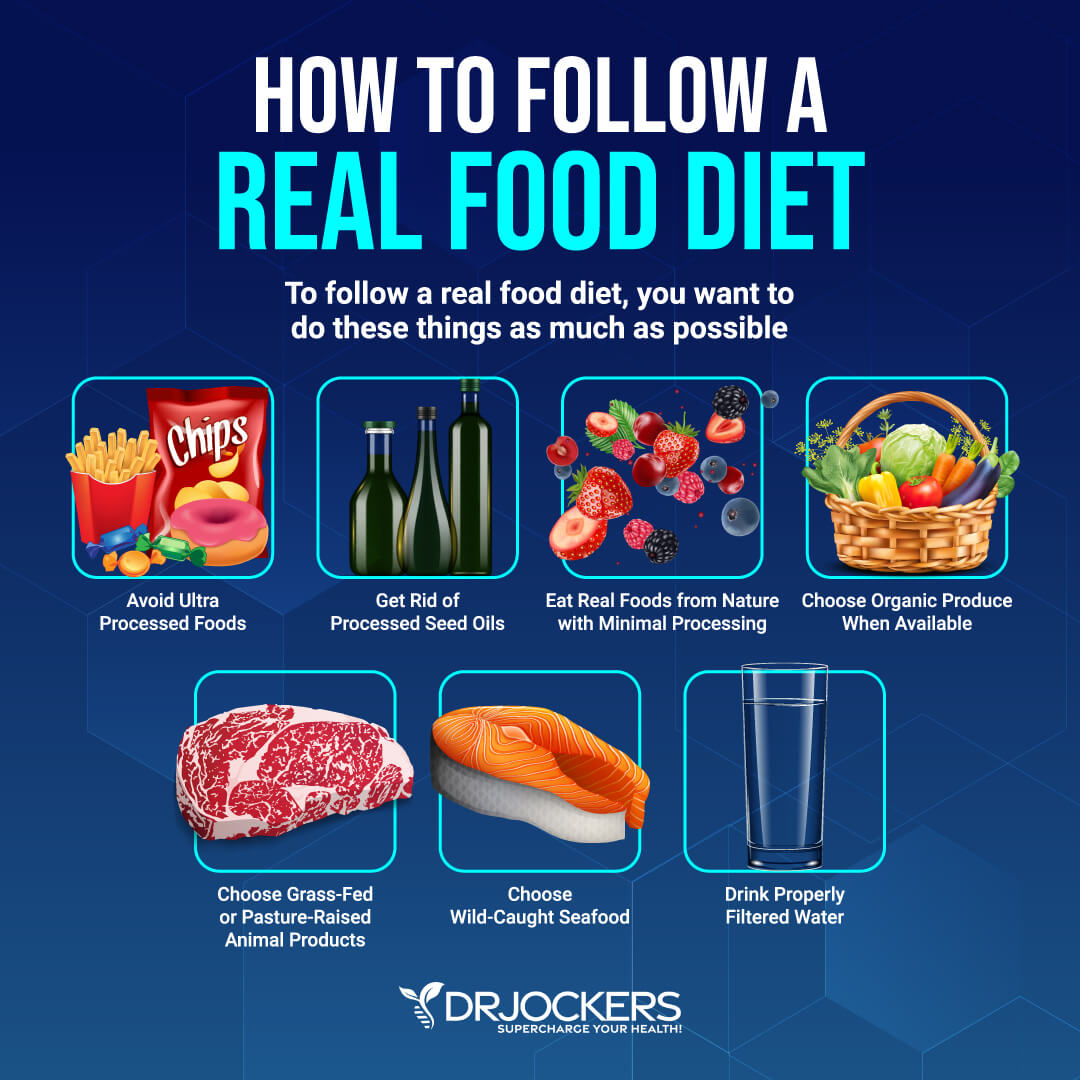
Choose Natural Cleaning and Laundry Agents
Just like with your personal hygiene and beauty products, be careful with your choices and reduce microplastic exposure.
Conventional options may contain microplastics and other plastics and are also stored in plastic containers. Instead of conventional options, choose organic, natural, and DIY alternatives for your safety.
Truly Free is a US company from Michigan that makes natural laundry practices better. And it’s affordable and good for your budget. They offer a 100% no-risk, 30-day money-back guarantee. Use the link here to get 100 loads for free and use the coupon code DRJOCKERS at checkout to save an extra 30% off your order.
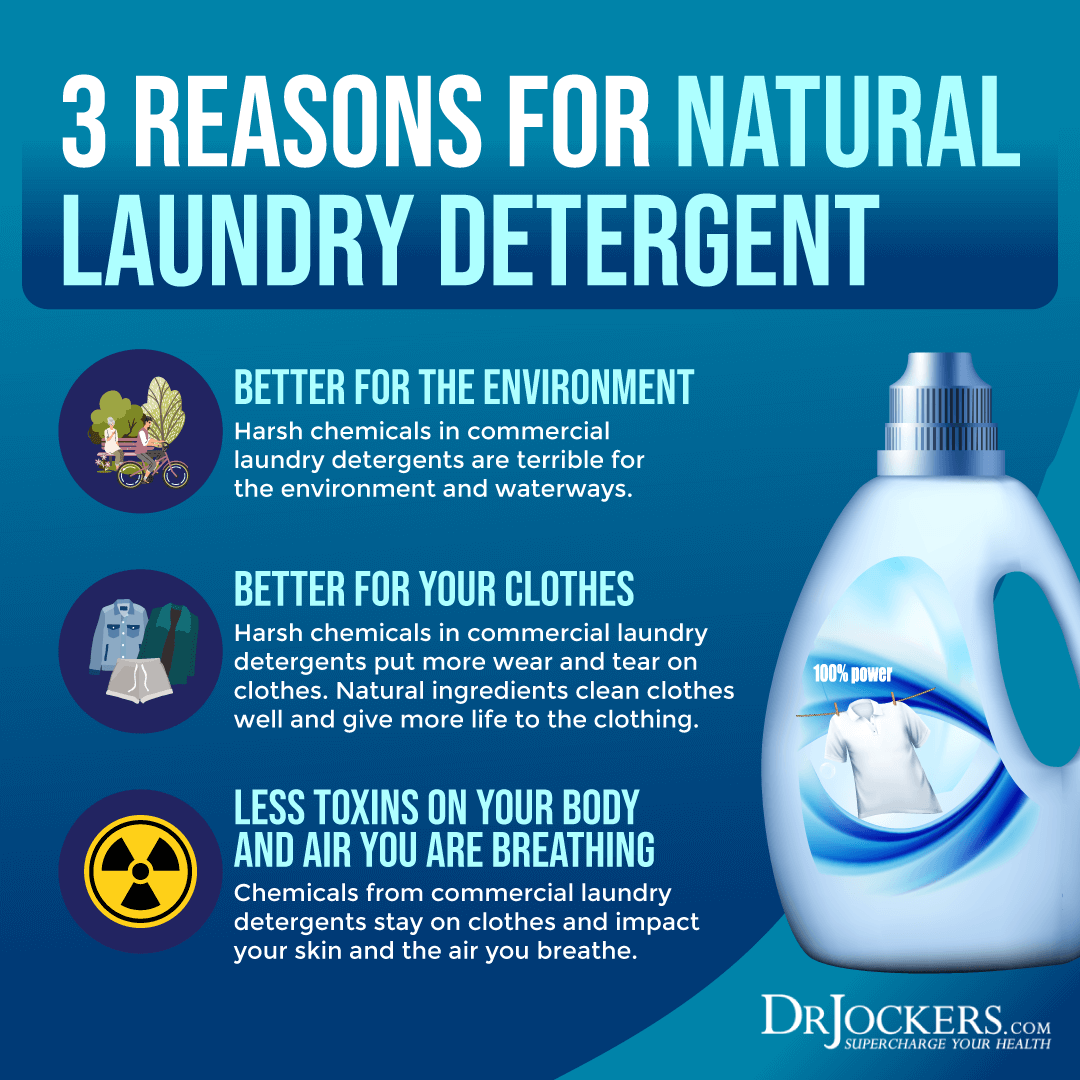
Good Water Filtration
Regular municipal tap water can be loaded with toxins, and water sold in plastic bottles poses the risk of toxicity for plastics and microplastics. Being smart about your water intake is critical. I recommend investing in a good water filtration system for your home.
Drink from glass or stainless-steel mugs. If you must buy water outside of your home, I recommend purchasing spring or mineral water sold in glass or stainless-steel bottles. You can also buy water bottles with a water filter to help you if you ever need to refill your bottle from a water fountain.
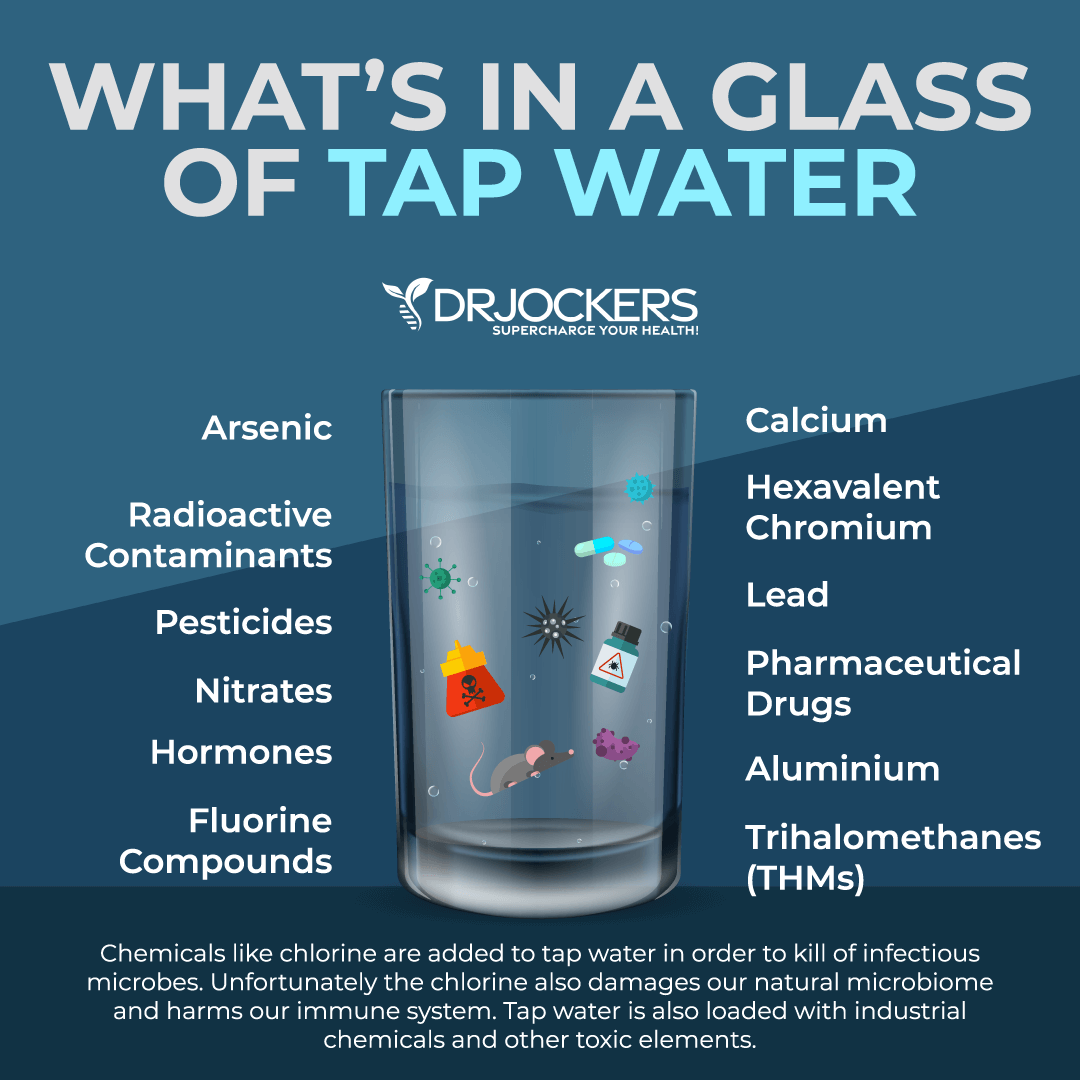
Good Air Filtration
Microplastics can get into your indoor air simply through air circulation and products that contain microplastics. I recommend that you vacuum your home regularly and keep everything clean to reduce microplastic exposure.
I also recommend investing in a high-quality air filtration system and using it all around your home, in every room, to reduce exposure to microplastics, mold, and other indoor air toxins and pollutants. House plants may also help to improve your indoor air quality.
I recommend that you get a HEPA filter that meets the necessary standards and captures 99.97 percent or more of pollutants at 0.3 microns. I recommend the Air Doctor with a hospital-grade HEPA filter for your home, along with a dual action gas trap VOC filter to deactivate major indoor air toxins.
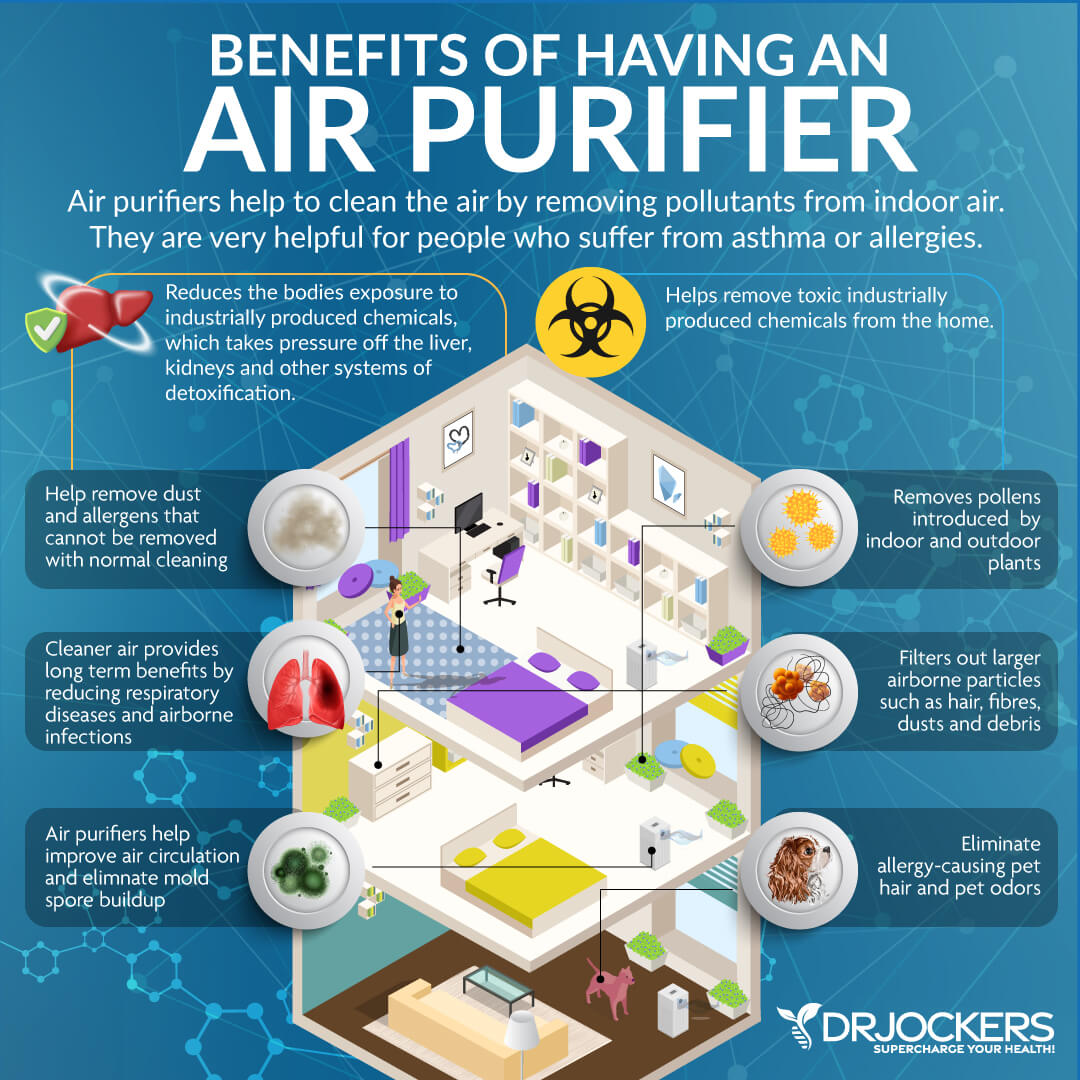
Castor Oil Packs
Castor oil packs have been around since ancient Egypt. They may help to promote the circulation of blood around an organ, around an area of your body, and increase the flow of fluids through your lymphatic system. They support detoxification and the removal of microplastics from the body.
To use castor oil packs, relax on your back, add some castor oil on your belly and massage it clockwise, put a flannel cloth on your belly, place a hot water bottle on top, and cover it with a towel. Relax like this for 45 minutes to an hour. To learn more about the benefits and usage of castor oil packs, I recommend reading this article.
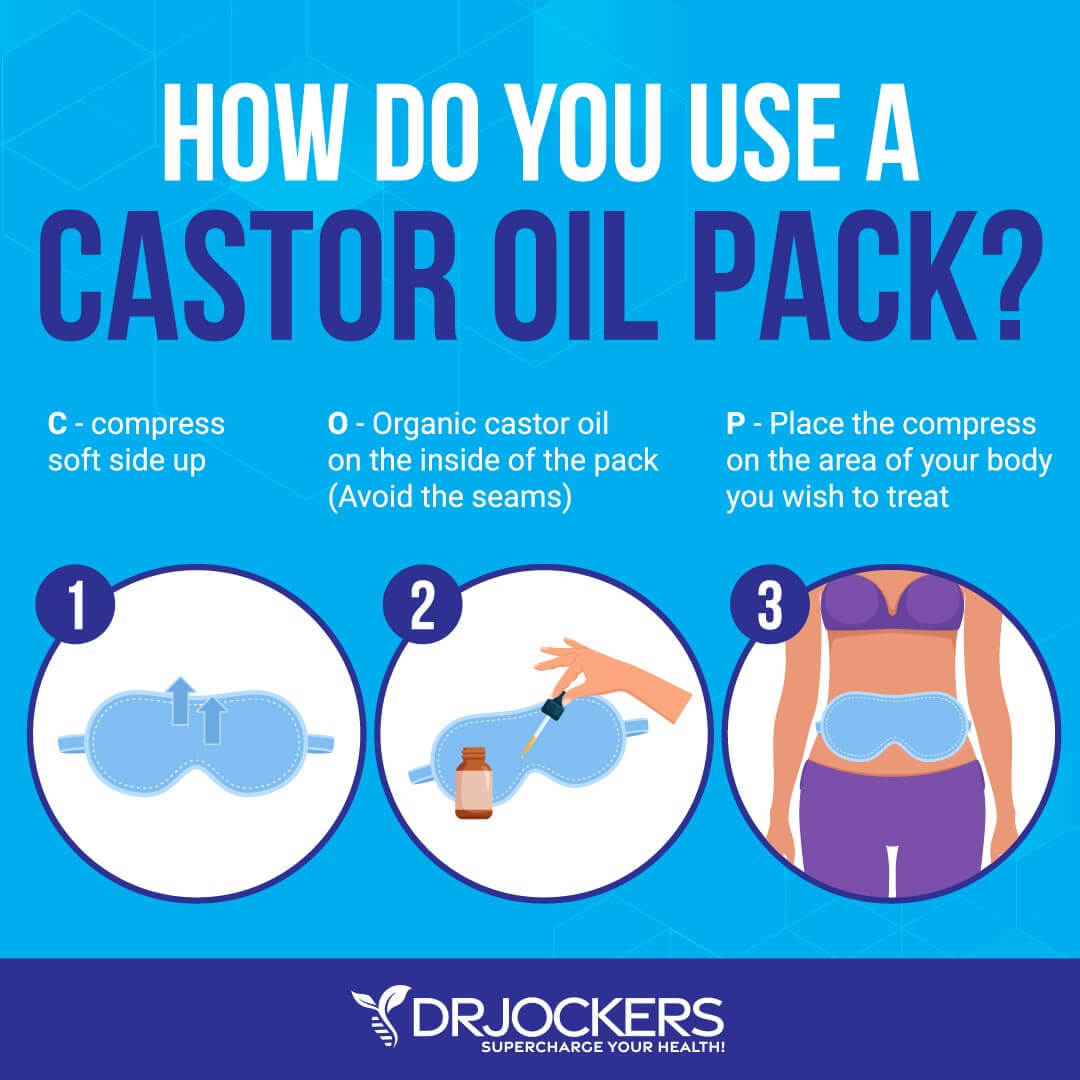
Use Bioactive Carbons
Bioactive Carbons are a form of carbon that helps to create and sustain life in a cell. They support detoxification and overall health. They include two essential plant-based acid extracts: fulvic and humic acid. Both of these extracts are compounds made up of carbon, hydrogen, and oxygen, the same elements that also make up nearly all of your body.
It is not surprising that bioactive carbons may help your body fight pathogens and toxins, support your immune system, and improve your overall health. To detox microplastics, I recommend HM-ET Binder. I usually have my clients do 1–2 caps, 2–3 times daily for 3–6 months to help clear these toxins.
To support the mineralization of your body and cell energy, I recommend CT-Minerals, which is a great thing to use while taking the bioactive carbon binders to support mitochondrial energy levels. To learn more about bioactive carbons, I recommend reading this article.
Final Thoughts
Microplastics are very small pieces of plastic materials that are smaller than 5 millimeters. They can be found everywhere, including clothing, cosmetics, personal care products, plastic containers, and seafood.
Microplastics are not only hazardous to our environment and wildlife but are also incredibly harmful to our human health. They can be found in our human bodies, including our blood. It is critical that you reduce your exposure to microplastics using the steps outlined in this article.
It is also critical that you detoxify your body from any past and present microplastic exposure. I recommend that you read this article on toxins and how to detox from them and follow the steps outlined there to detoxify from microplastics.
If you want to work with a functional health coach, I recommend this article with tips on how to find a great coach. Our website offers long-distance functional health coaching programs with our world-class team of health coaches. For further support with your health and other goals, just reach out—our fantastic coaches are here to support your journey.
Inflammation Crushing Ebundle
The Inflammation Crushing Ebundle is designed to help you improve your brain, liver, immune system and discover the healing strategies, foods and recipes to burn fat, reduce inflammation and Thrive in Life!
As a doctor of natural medicine, I have spent the past 20 years studying the best healing strategies and worked with hundreds of coaching clients, helping them overcome chronic health conditions and optimize their overall health.
In our Inflammation Crushing Ebundle, I have put together my very best strategies to reduce inflammation and optimize your healing potential. Take a look at what you will get inside these valuable guides below!





